Process:
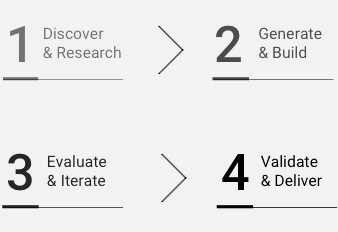
VR Simulator for PC VR

Based on my research and survey, I started working on the prototype and visual identity for pet simulation experience. This app with the working title "VR Pets" is intended for everyone who always wanted to have a pet but wasn't able to make it happen, as well as for everyone willing to practice being a pet owner before actually getting a real one. This simulation will help to teach responsibility, empathy, and routine development. And regular tasks and engaging activities will form habits which will increase the play time and profitability.
I was looking for the type of virtual world, experience that would be unique for VR, that would be exciting, friendly and social, would help to unite despite distance or some natural life events. I continued researching. I also kept analyzing VR applications that work on socila VR, talked to people who used them. More companies that work on social VR appeared along the way, and I made sure I checked the products they work on and their vision behind these products.
And based on my personal experience I came up with several hypotheses, one of which was creating a VR world where the player could get a virtual pet in order to entertain and to solve several problems that pet owners face in RR. To make sure that this idea follows the actual needs and motivations of other people and that people are actually interested in such type of product, I followed User-Centered Design techniques that included research and interviews.
I successfully validted my hypothesis by talking to at least 19 people about this type of experience, 19 of 19 were very positive about such type of game. As well, the fact that many people love pets, was undeniable with 19 of 19 people stating they like pets. The only difference was that they are different types of pets that people prefer, so it would be preferred if the players could select them. Other aspect that revealed the necessity to create a pet related experience was that not all people who wanted to have a pet, actually could. Some had allergies that kept them away from any pets, others were not able to have a pet due to living conditions not suitable for pet, or pets were not allowed in the house/ apartment, others couldn't afford to care for pet.
One of the other inspirations was Tamagotchi by Bandai – a virtual pet simulation game. It goes through several stages of growth, and will develop differently depending on the care the player provides.
Definitely, I checked the Job Simulator by Owlchemy Labs as an example of a successful VR sim game. It confirmed my findngs and supported my hypotheses that people in general like simulators, that they would love to have a pet in VR which they could play with and feed.
The majority of people like pets in games and real life, and it was confirmed not only by my online reaserch but also by surveying people of various ages. All people stated that they love pets, varying by type they prefer (some liked all) – dog, cat, Guinea pig, bird etc. The most mentioned pets were dogs and cats. The most loved pet among children was a dog. Adults split between dogs and cats. And the research showed that kids love pets more than adults. The large part of TA for this application consists of young people 10-18 years old, so I selected a dog pet as a first one to work on. To confirm the VR game preference and see if people were honest in the surveys, I conduct tests along the VR development.
I was also considering to have unusual creatures that wouldn't be found in real life but to gradually adapt people to VR using the existing affordances and intuitive behaviours, the dog was selected.
My research included interviews and surveys, as well as online communities research on what people discuss and what they wish to exist in VR. Here are some examples of many discussions I found on Reddit.
The pet preferences slightly differed between reddit communities, school students, and some adults. But all people indicated that they'd like to have some virtual pet creature.
Among my studies was also pet themed VR and non-VR game research. I checked "My Own Pet" on Steam, Oculus' Farlands, Pokémon Go, Neko Atsume: Kitty Collector, Konrad the Kitten, and other.
The reason to create this type of experience is as well connected to my personal experience as a dog lover and owner, which helped me to understand better both, the pets and their owners.
This pet world is not inteded to replace real pets but to entertain; prepare to have a real pet; teach responsibility, help learning empathy and compassion; give accompany; simulate a pet at the possible extent of current technology (which is being developed along the way) to those who can't have one; and to help with socializing in VR.
Having this initial research, I decided to start working on the gameplay, interactions and character, and pivot on the best direction along the way, when the tests will uncover more of people's preferences or hidden motifs.
Below are the details of my story some of the moments of which would most likely be familiar to many of those who has or used to have a dog, or who always wanted to.
Constraints
I always wanted to have a huge dog like fluffy St. Bernard when I was a child, but living in a big city it wasn't that easy due to many factors:
Limited living space which seemed to be important for a large dog, busy schedule – everyone including myself was permanently out busy with work, schools and various classes, up until the late evening.
Long fur would require more often cleanings, as well as any pet needs attention, care and walks on a regular basis.
As an addition to that, one of my family members was at that time sensitive to some allergens, which all together seemed impossible to have a big pet like dog. But once upon a time, everything changed and we ended up having 2 amazing dogs, the smartest and the best I've ever known. It was an interesting and long story an experience of which helped me in identifying the issues related to pet ownership and in suggesting possible solutions based on people's wishes and values.
Long Story Short
We spent many happy years together with our dogs. They were my best friends who learnt to understand my natural speech, gestures and bahviours (not just commands), always gave me accompany and made me feel special and loved, which created a special bond that could be only wished to last forever. I graduated from school, started University and was finishing the 3-rd year when the lifechanging event happened – after weeks of everyday treatments and 6 hour-long drop counters the doctors concluded that there is no hope anymore... and so – my beloved dog passed away. Years later we experienced the similar situation with our second dog.
Those were heartbreaking events for everyone, which as well led to some conclusions and helped me to form hypotheses which I will pinpoint below.
Children and their parents, young adults.
People with various constraints that prevent them from having a pet (health, living situation, costs (maintenance, care, required shots), absense (e.g. frequent business trips) etc.).
Everyone who needs to have a companion but can't due to the traumatic situations related to pet death or unavoidable illnesses (in some breeds).
Everyone who wants to experience and practice taking care of a pet before getting a real one.
Inability to have a dog due to various difficulties.
Lack of detailed pet related experiences with a well-thought gameplays suitable for different age groups and tastes.
Inability to have a pet due to the pet death related trauma.
Lack of knowledge and practice when getting a real dog.
Make it possible for everyone to have a pet, despite any constraints such as health, space, time, costs.
Help people to socialize with other VR participants (VR MMO).
Help people to become better pet-owners by practicing pet care, learning empathy, providing information about the pets for the first-time owners, all hands-on. Let people FEEL being a pet owner before involving themselves into this adventure.
Deliver a fun, educational, and humane entertainment.
Player's Value
Entertainment
Pet care hands-on education
Lifetime companionship that won't stop (if the virtual pet is treated appropriately).
Possibility to esily meet new people in VR, socialize. A way for shy people to establish friendship through pet, VR avatar, and virtual environments.
Business Value
In-game assets. Distribution and use.
Growing user base
Continuous players' feedback helping to create better products.
Measurement of Success (for the near future, as it changes quickly, same as company goals change. So I regularly revisit them.)
Positive feedback and growing user base.
More precise TA dicovery
Clear identification of the product to build, feature or other value to create.
Active feedback and engagement.
New partnerships.
Based on my personal experience and on my talks with people who could possibly use this application, I formed several hypotheses, consolidated below:
The pet experience will help sensitive people to avoid trauma related to pet death which is unevitable in real life.
Replacing death with other suitable event will keep the player focused, but won't traumatize.
People that can't have a pet due to various constraints that are uncompatible with the dog will like the virtual pet experience.
The virtual pet will help lonely people to feel accompanied, it may even help with depression by positive distractions. This definitely needs to be tested and confirmed in the proper environment. The users could include bed-tied patients who want to have a companion that can be present and interacted with anytime.
Having a virtual pet will help teaching responsibility, as well as learning empathy and compassion. It can be a good dog care training before having a real dog, as well.
1. Keep discovering TA through tests and interviews (use events and expos for user engagement).
2. Sketch and storyboard ideas. Define the possible flows.
3. Create small protoypes, test interactions and affordances. Evaluate based on VR heuristics. Iterate.
4. Add 3D (characters and environment), make "grey box" prototypes. Evaluate. Test with new and experienced VR users. Iterate.
5. Add visual design and sound. Evaluate, test and iterate.
Based on the research and qualitative data, I developed the archetypes of people’s behaviors, needs, goals and motivations, problems and mental models.
The discoveries resulted in 3 Personas:
World Changer and New Pet Owner (Primary Personas), Co-Pilot (Secondary Persona). All based on TA and on peviously developed Personas. More of the Persona creation process is here. Personas may change or be updated along the way as a result of my continuous research.
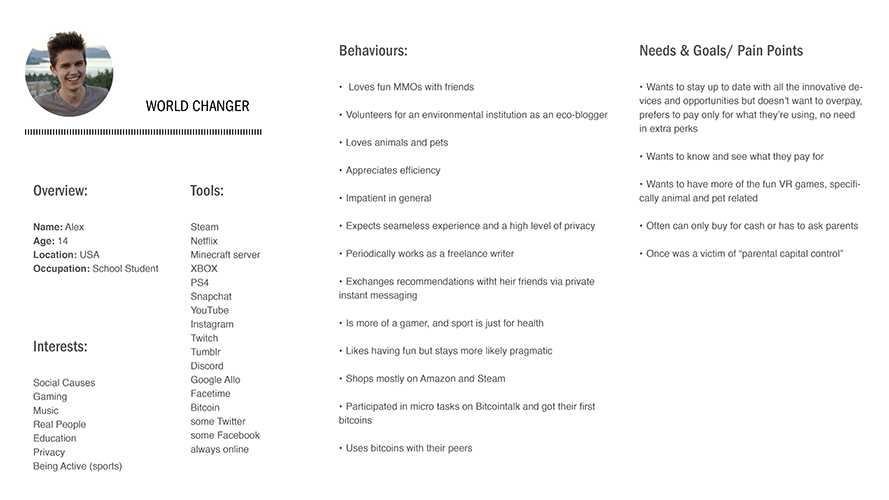


1. Practicing pet care skills.
2. Enjoying a virtual pet friend as a single player.
3. Socializing and playing with friends and pets in VR world (VR multiplayer).
4. Teaching empathy, responsibility, routine development.
5. Therapy dog, emotional support.
As usual, I mind mapped some of the ideas. I used Spherical Storyboarding to define the user flow and decide on the character and objects' positions in the VR space. I mostly used the GV Sprint techniques adapted for VR. Crazy 8 became Crazy 6 – for quick Scene Storyboarding (Crazy 16 in total, but I only used 6 squares for each full scene) – I folded the paper to create squares imitating cubemaps. Sometimes I also used squares randomly (like Crazy 16) to quickly draw some FOV ideas that could be applied to different scenes.


Use Case #1 (left). Socializing and playing with friends and pets in VR world (left).
Use Case #2 (right) Enjoying a virtual pet friend as a single player (right), getting a pet.
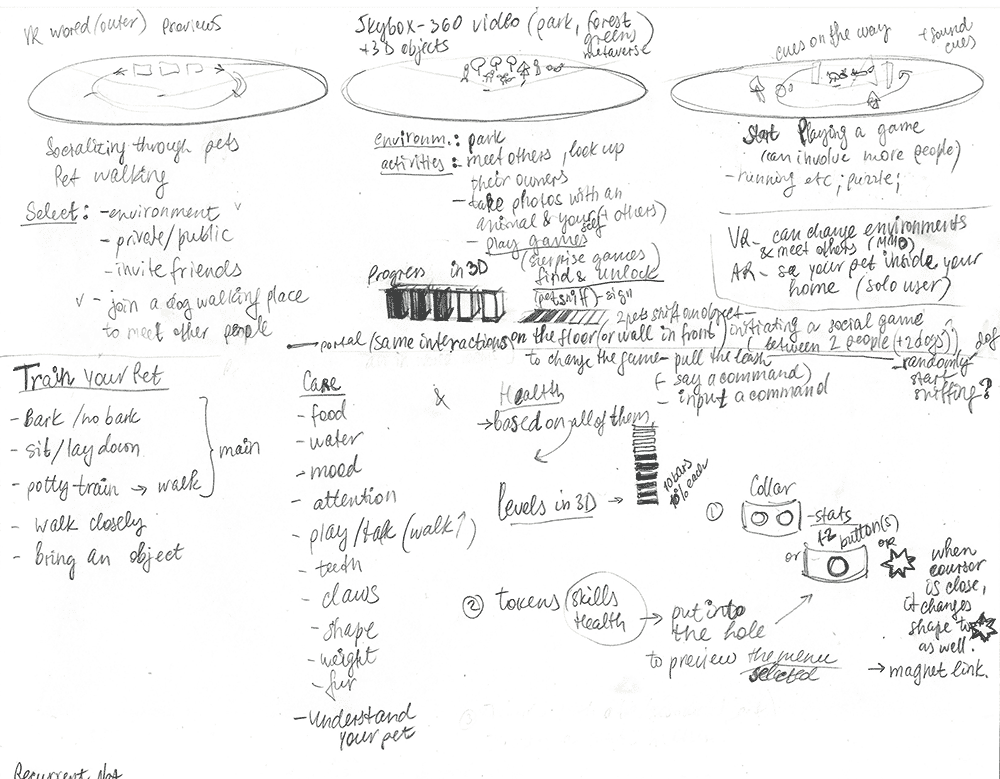
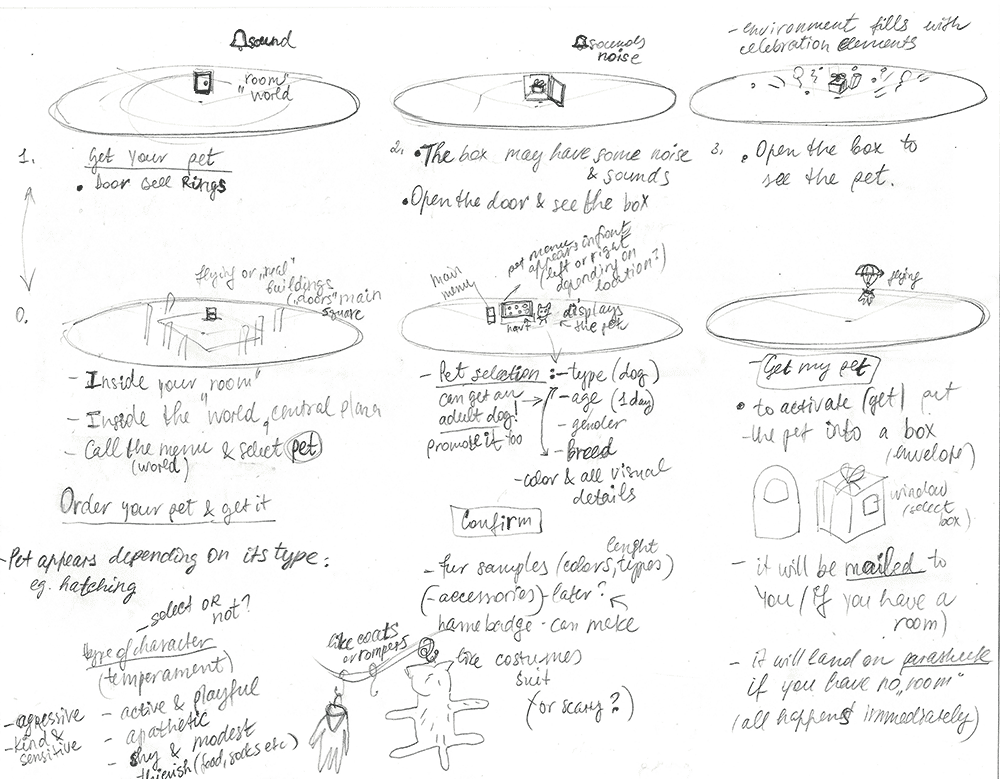
Next, I did some scene sketches using tablet, previewed them in VR to select the directions for further development. Similar to these (scene preview example).
Next prototyping stage is similar to wireframing in UX design – 3D grey boxes as objects with attatched interactions, but no 3D and visual art yet.
After it was decided which ideas to develop and test further, I started working on small 3D prototypes intended to test intractions, locations in 3D space and scale one more time. I also relied on the distances that are considered comfortable for VR, setting them up in Unity3D and immediately testing on my phone.
I kept skyboxes as quick scene drafts for objects' position, scale and color evaluation, and then moved straight to 3D layouting. Below are examples of 3D layouting utilizing grey boxes as objects, and testing solely interactions, locations, and scales.
To create an interactive prototype in Unity, depending on the complexity, I may write a pseudocode which I use as a guide to write an actual code, sometimes I may collaborate with a developer.
Below is an example of a prototype, testing the menu. The menu is locked to the player and moves within the world together with but not interfering with the player, can be called anytime with Cardboard's button or controllers if using more advanced HMDs. Can be adjusted (angle, x, y, z vector location), the position will be fixed and next time the menu is called, it will appear in the desired place as adjusted.
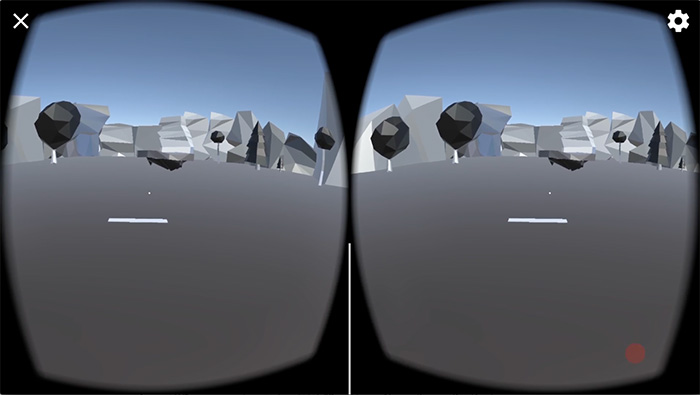

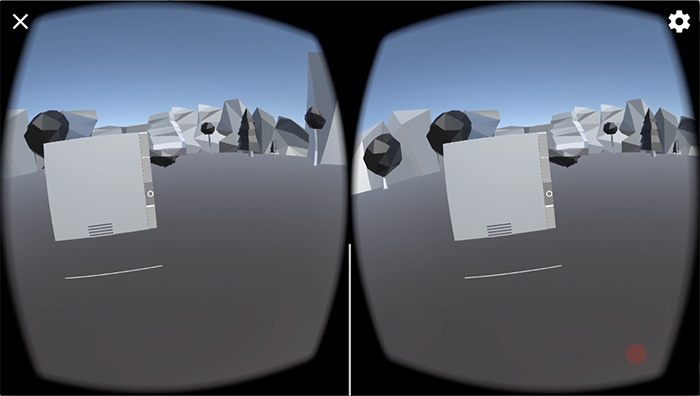
Below is an example of the volumetric pet menu that would be tied to each VR pet. It can be called when clicking on collar. I am testing the convenince of such interaction to establish how comfortable and easy it is to aim for the collar at various distances (and with 2 types of controllers – cardboard indirect button and Oculus/ Vive type controllers – to be tested).
Depending on the results, the button might migrate from the collar to the whole dog body or bigger parts like head or body. Menu appearance motion style – Material design animations with easing.
I created a flat type of menu and a volumetric, or cube, menu to test them and to establish the best solution. Viewing in VR helped to iterate several times on the colors, brightness and approximate lighing intensity that would be in the scene, which is helpful right from the initial stage of VR prototyping.
The labelling on the pet menu was selected based on an internal card sort I made, and will be iterated on along the way. The arrows and rotation direction are being tested as well to establish which scenario people naturally expect.
An example of directional sound positioning inside the scene – in the scheme below (front and left sides of the cubemap). Featuring the pet appearance (door ring as a directional sound source).
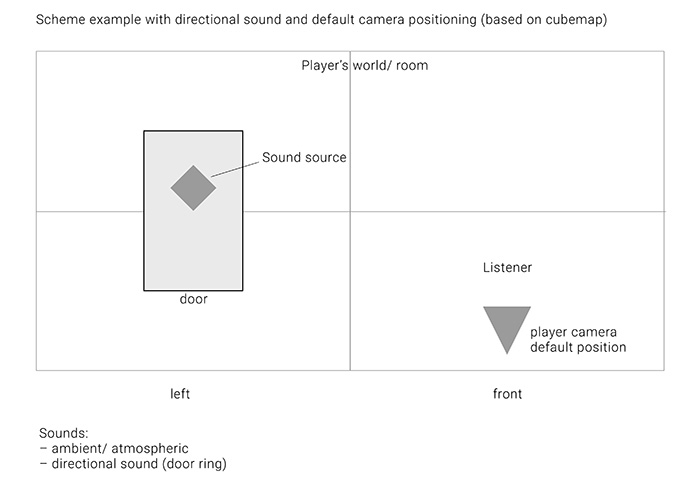
VR Oxygen's video blog that presents selected games was very useful, because while searching for a good VR game or experience to share, I tried different types of locomotion myself and learnt a lot from these games, taking notes of what I have found especially interesting and worth exploring more.
Before working on the prototype I also made a research of interactions in VR, analyzing the research results of some projects that used various VR locomotion techniques. I selected the following to explore: Redirected Walking, Tunneling and Chase Camera, limited movements (short movements without acceleration), dark surrounding area with the focus on the path only, Teleportation, Blur the view/ move/ unblur, another technique was used in a game called Lamper VR: thanks to the narrow corridor people didn't feel sick when playing this game, Cockpit (any device to be used for locomotion).
The experience should be accessible for everyone, I kept in mind some limitations the Redirected Walking will have, and looked for the ways to make a locomotion method selectable.
I also explored the Foveated Rendering which is actually the way we look at and process images – focusing on one point and seeing the rest slightly blurry, as well it could help to reduce the rendering workload.
I decided that capitalizing on people's existing knowledge would be the right way to create interactions and introduce people to VR. For example, such game as Gravity Pull VR uses Redirected Walking locomotion technique and Inspirit uses the technique when player should walk in cycles and select the path through gazing and direction selection – both locomotion techniques I've found interesting, and when testing these games at an expo, people liked these types of locomotion, finiding them engaging and unusual, and mostly didn't experience side effects or inconveniences when used with short breaks. These techniques should be used sparingly to avoid the feeling of disorientation and nausea, if walking in circles for long time (in RR).
VR Oxygen's video blog accumulated a research that was conducted with both, Cardboard VR games/ experiences and games for Vive and Oculus. Some of the other examples that were impactful in my research are Invasion and Aperture Robot Repair. They demonstarted a great VR user experience when the feeling of presence is imminent, as well as the connection with virtual creatures feels incredibly real – the feeling that the robot is coming directly onto the player wherever player moves, was achieved through the VR space size and VR environment behaviours that make the player move in certain directions – in Aperture Robot. Similarly, in Invasion the cute bunny is sniffing and looking directly into the face of player, which creates the feeling of being present in VR and communicating with this bunny.
Below are screenshots from both of the VR experiences and from one of my favorite and definitely successful VR caretures (as proved through the research I made on this game) – VR dog from "The Lab".
From top to bottom: The robot from "Aperture Robot Repair" by Valve, the robot dog from "The Lab" by Valve, the bunny from "Invasion" by Baobab Studios).
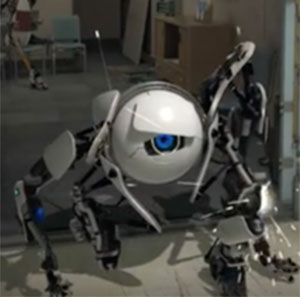
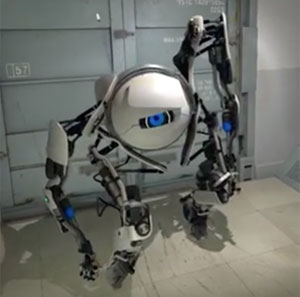
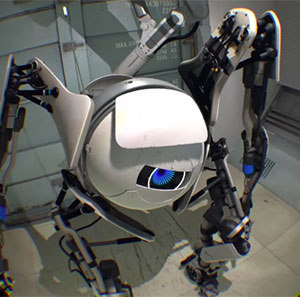
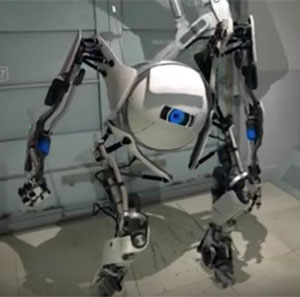
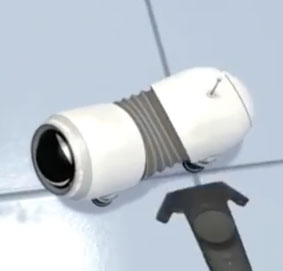
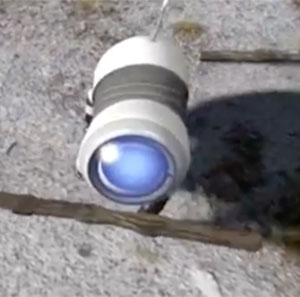
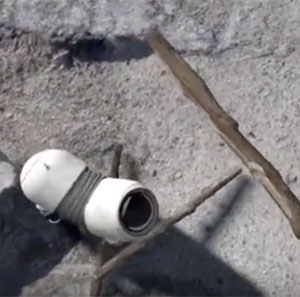
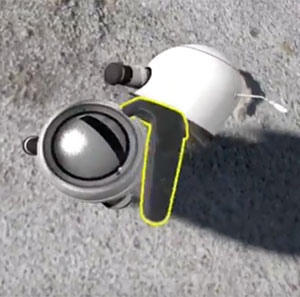
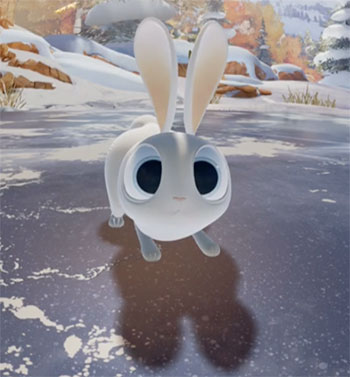

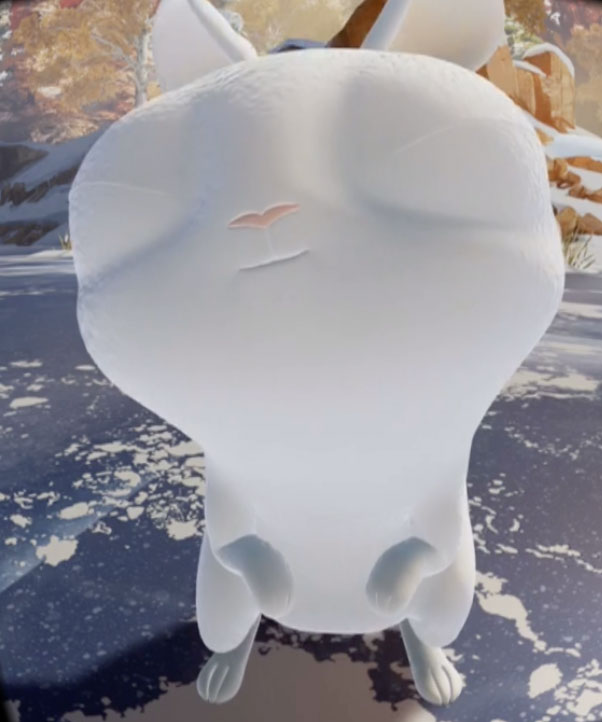
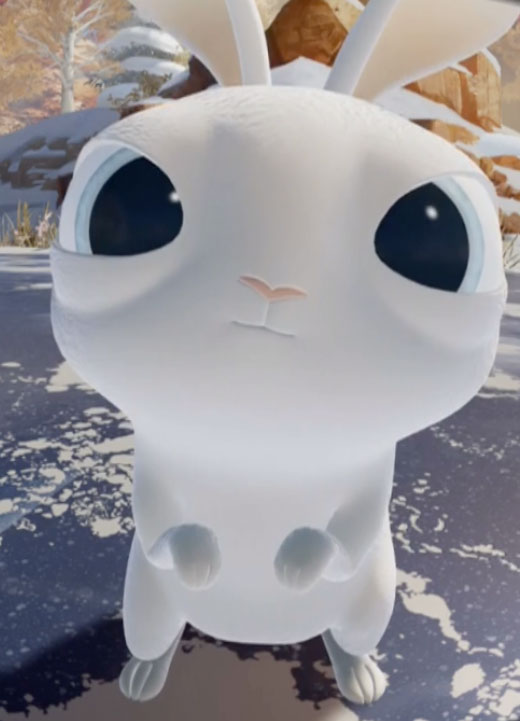
Among the other details I considered is psychological comfort and feeling of safety, which would include the personal space bubble and other relevant functionalities. To avoid inappropriate behaviours in VR, I considered having a verbal code of conduct that everyone should agree on when enetering the virtual world. It would be accessible as a set of rules in writing as well, for everyone with limited hearing abilities or when playing without sound.
I sketched a storyboard to quickly visualize scenes and interactions. Storyboard is an initial draft – some interactions and/ or menus/ buttons were changed after testing in VR.
Storyboarding interactions, menu, and a scene:
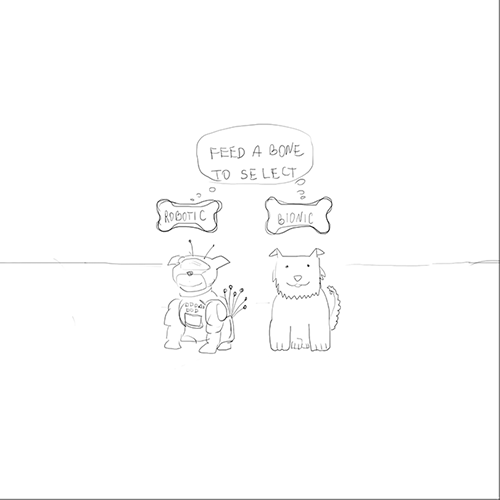
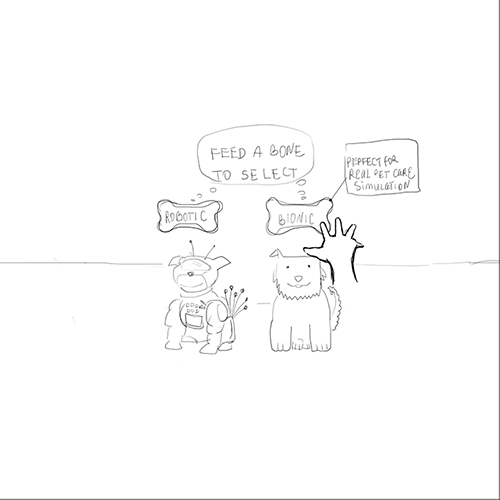
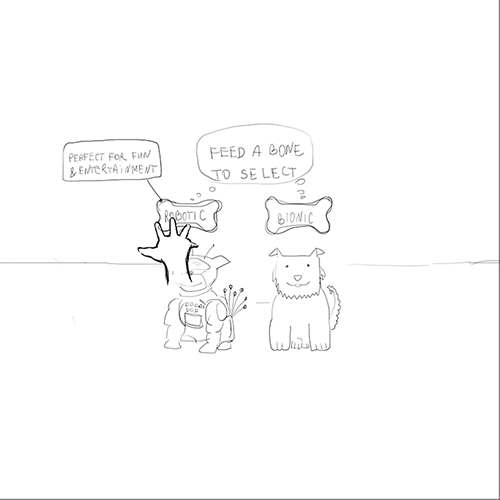
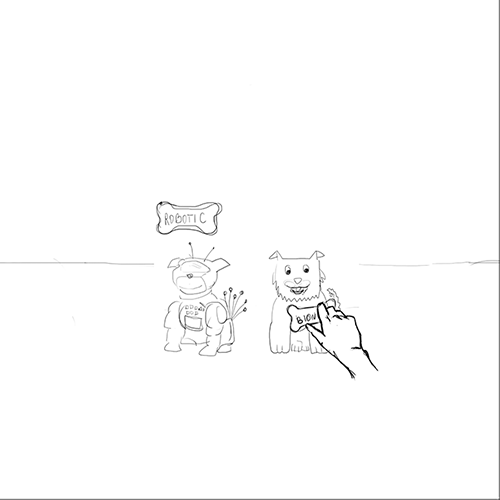
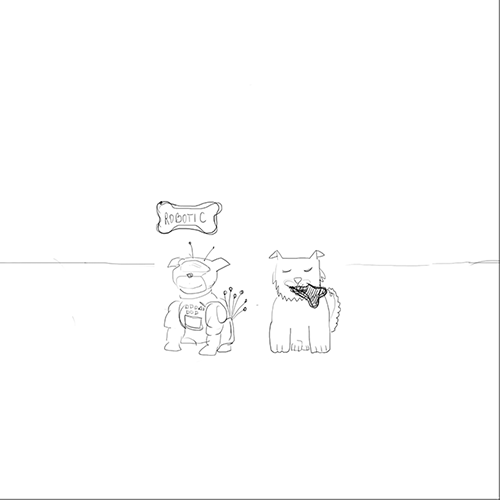
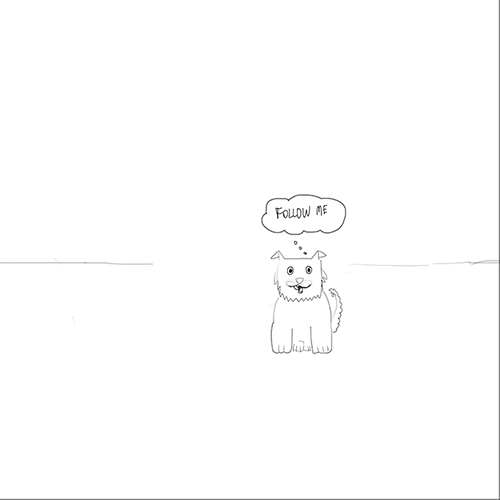
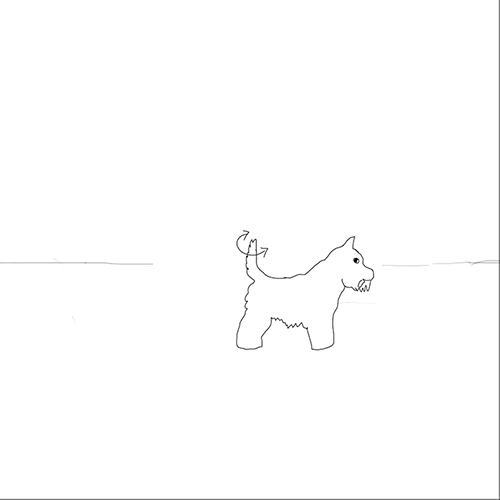
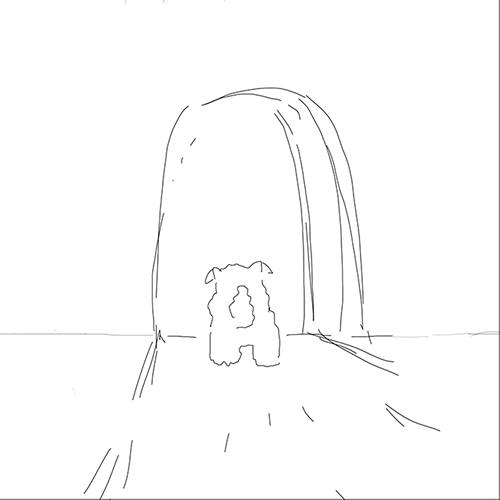


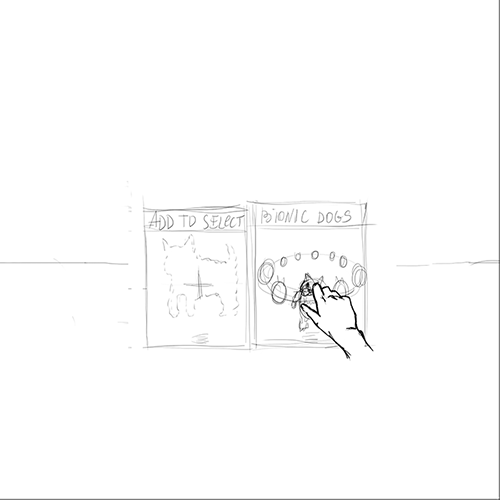

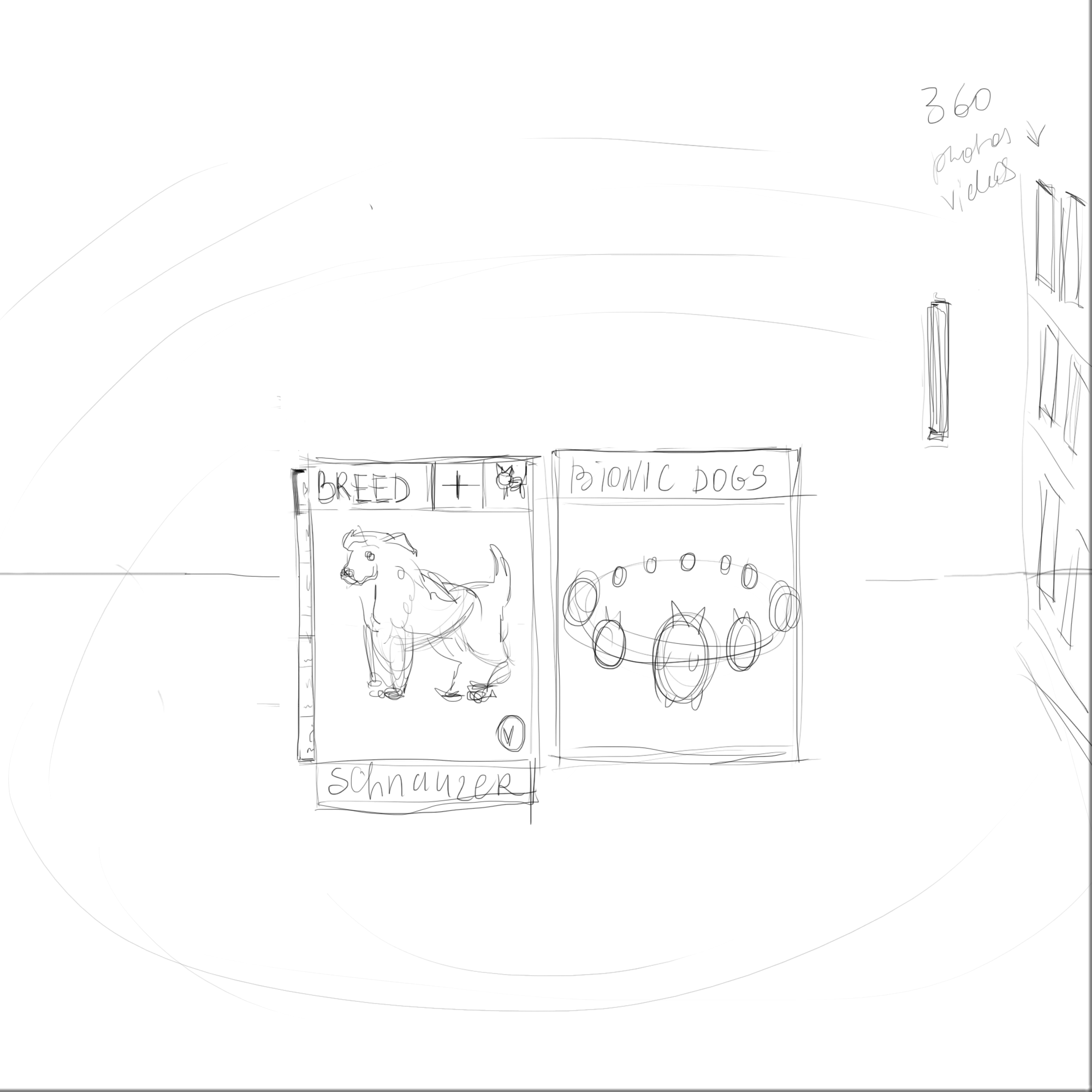


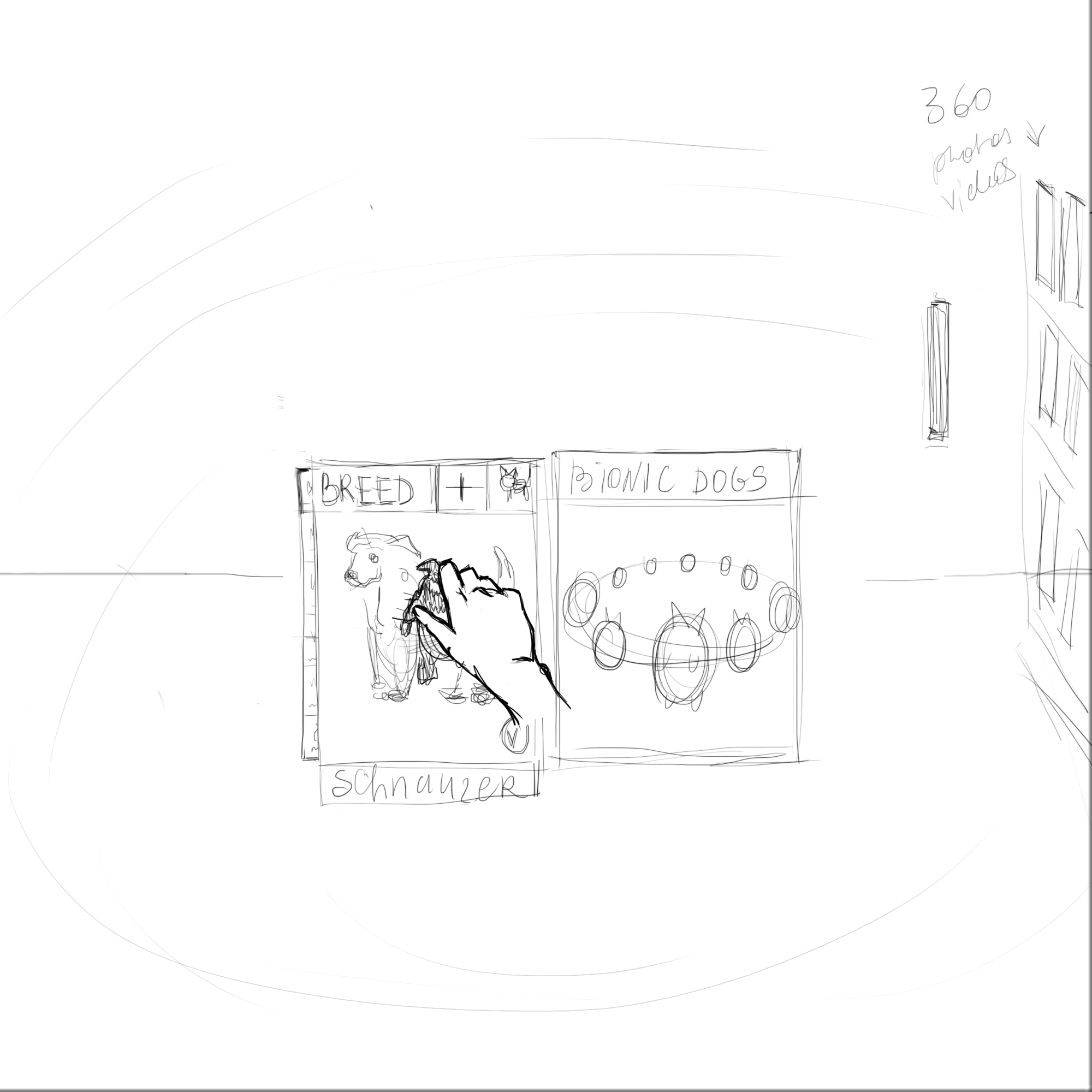
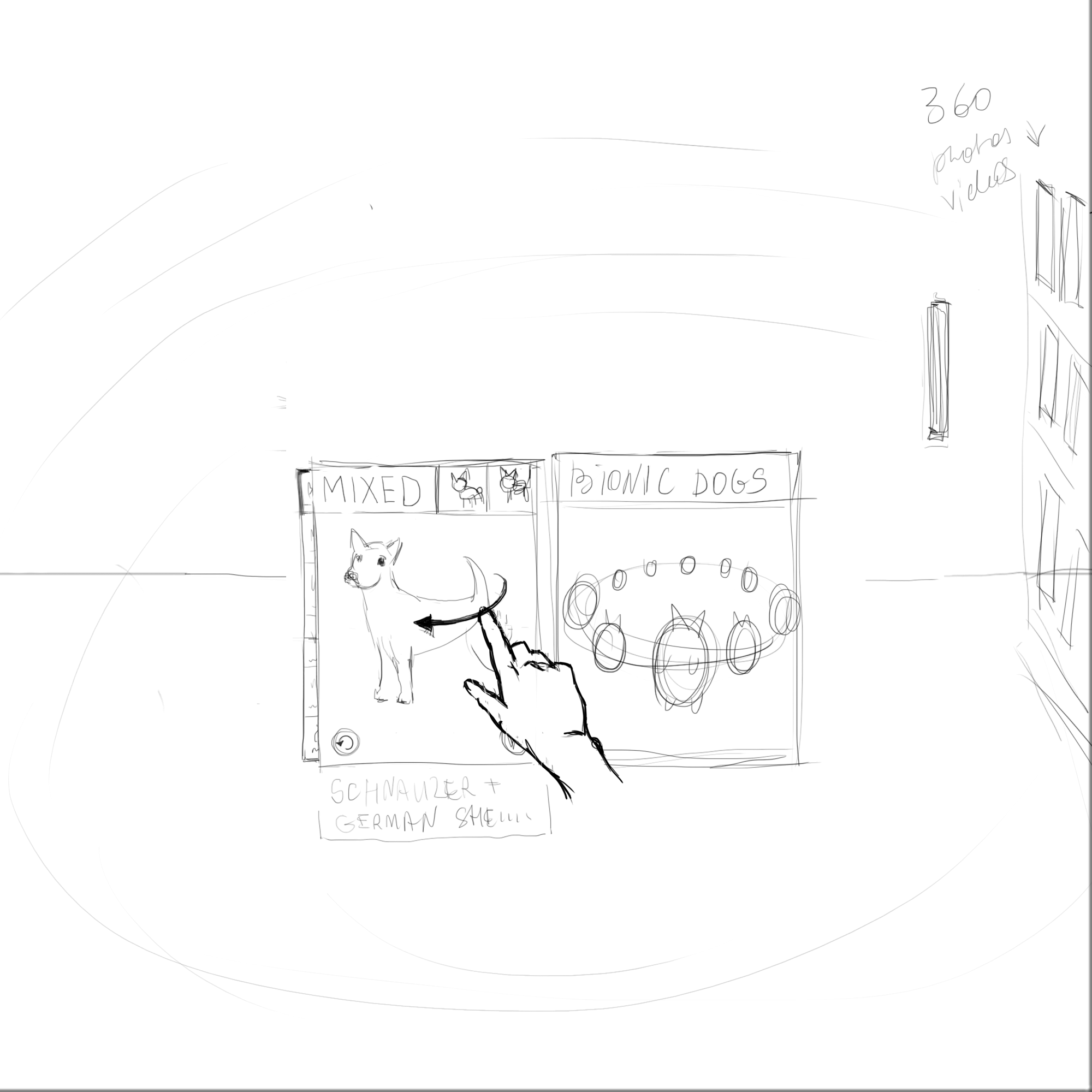
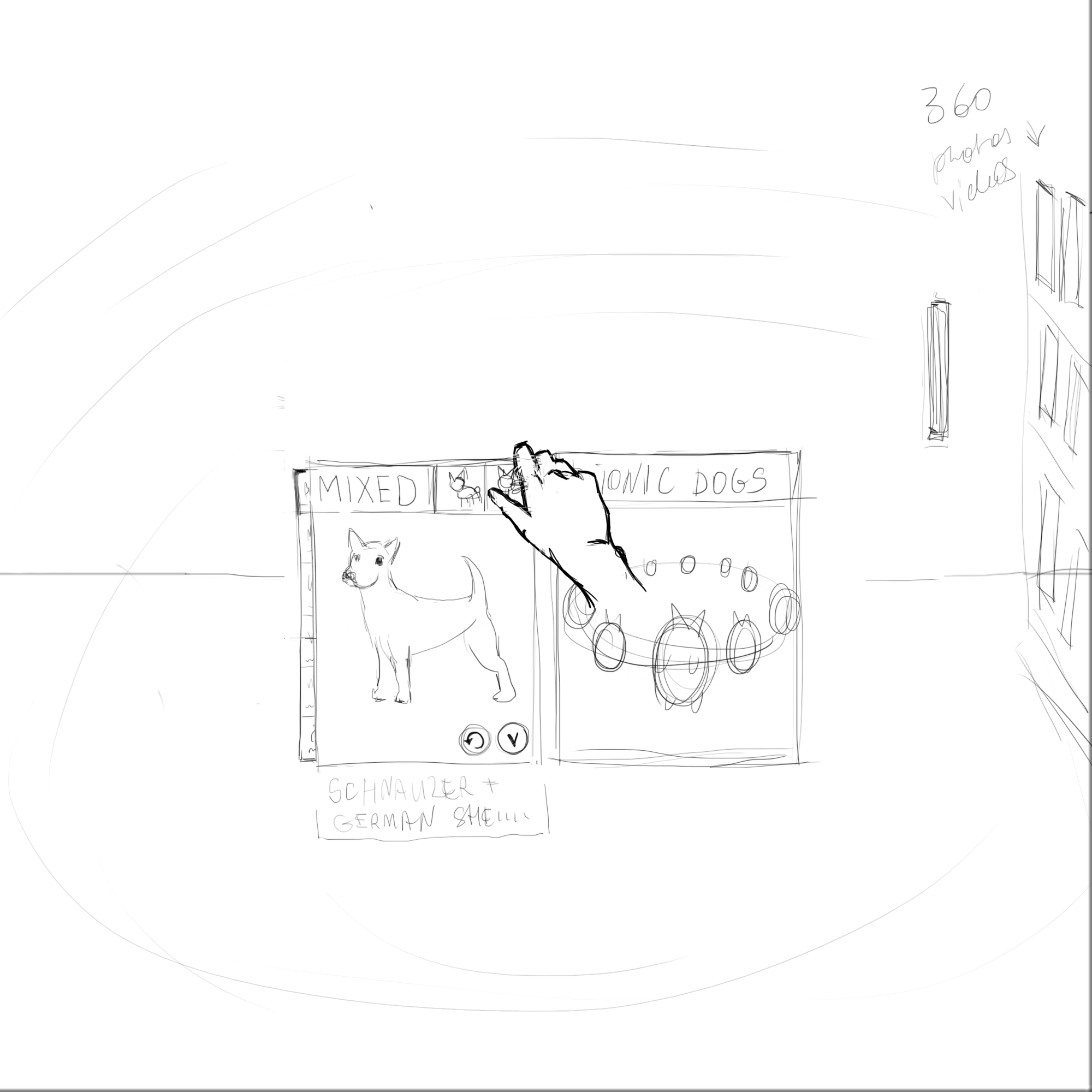
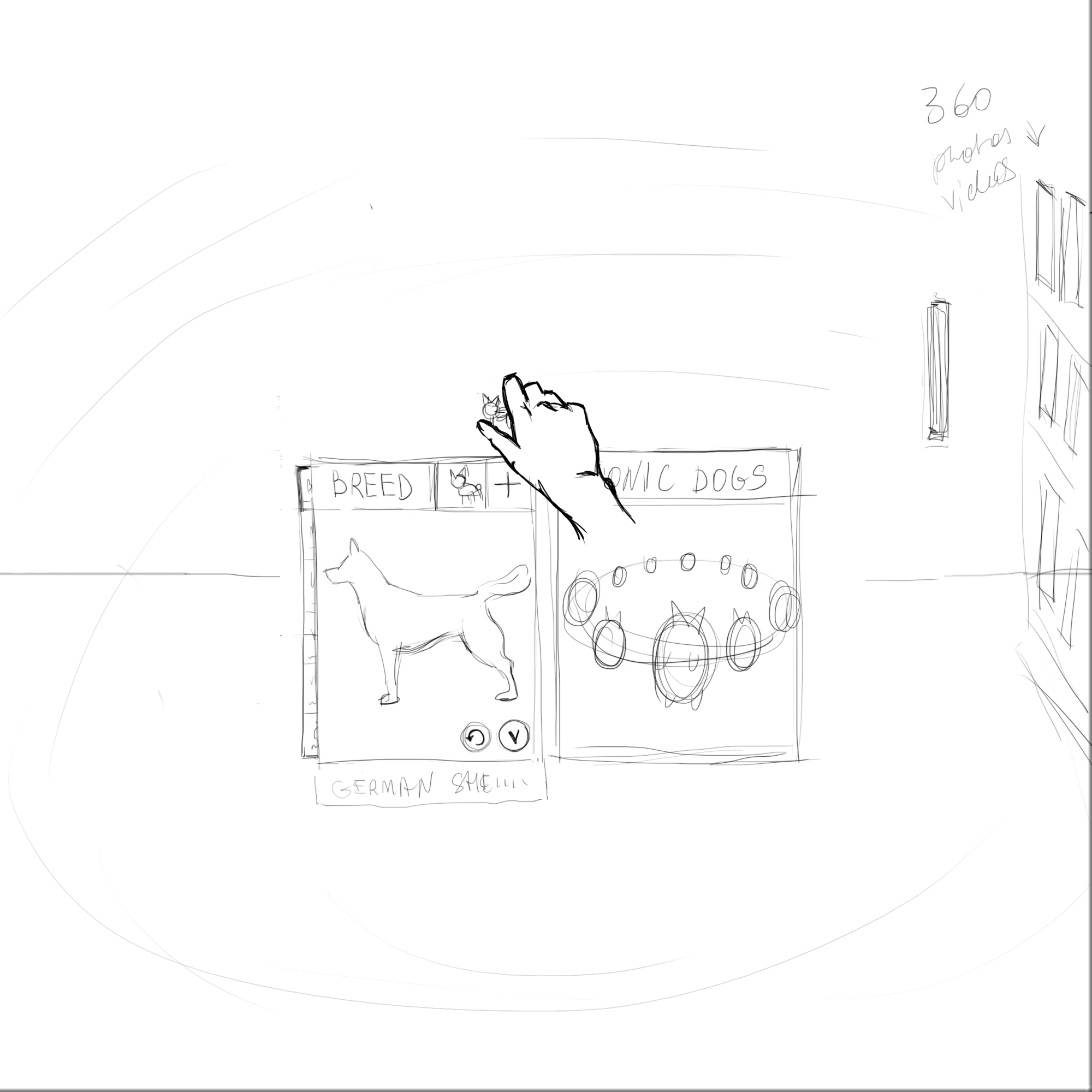
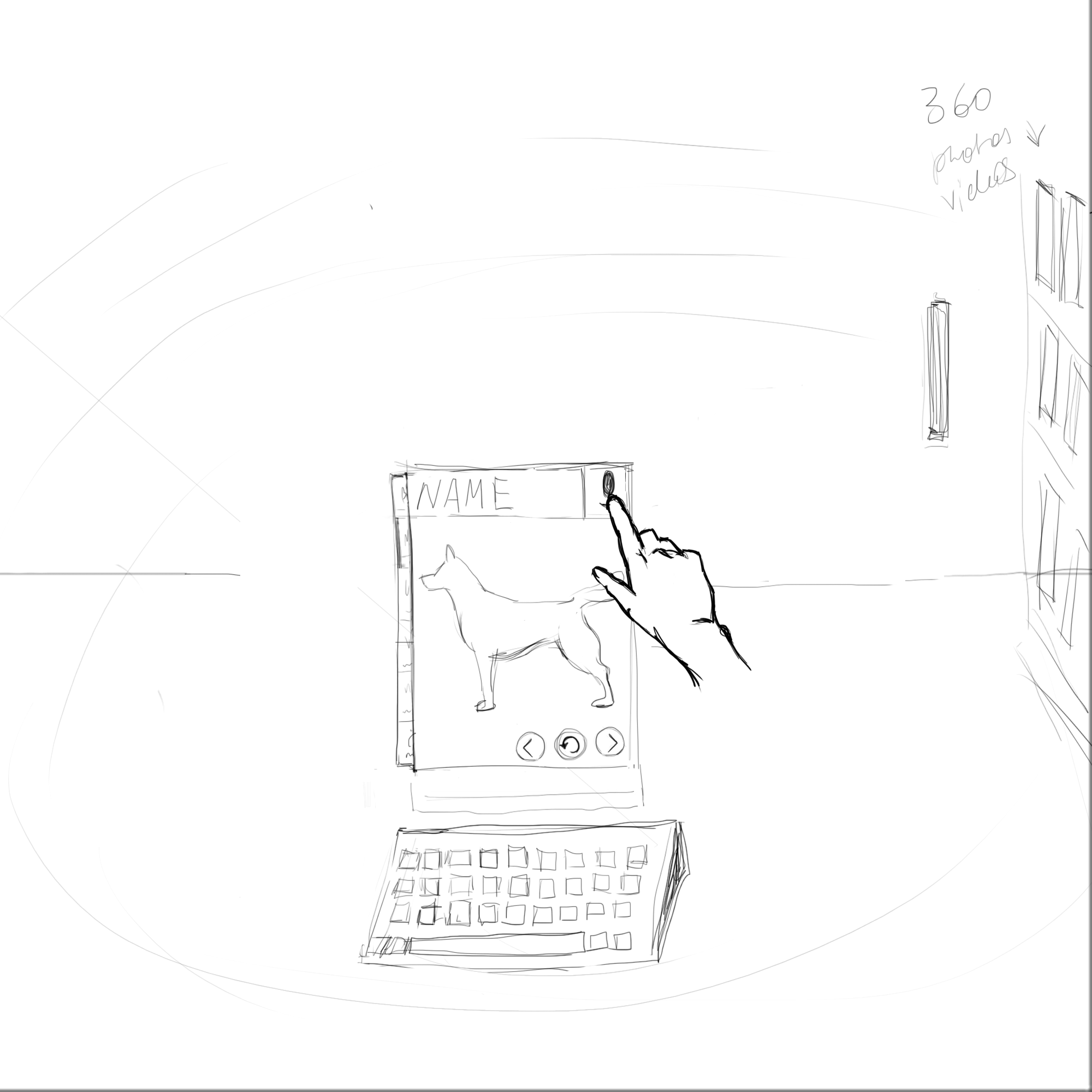
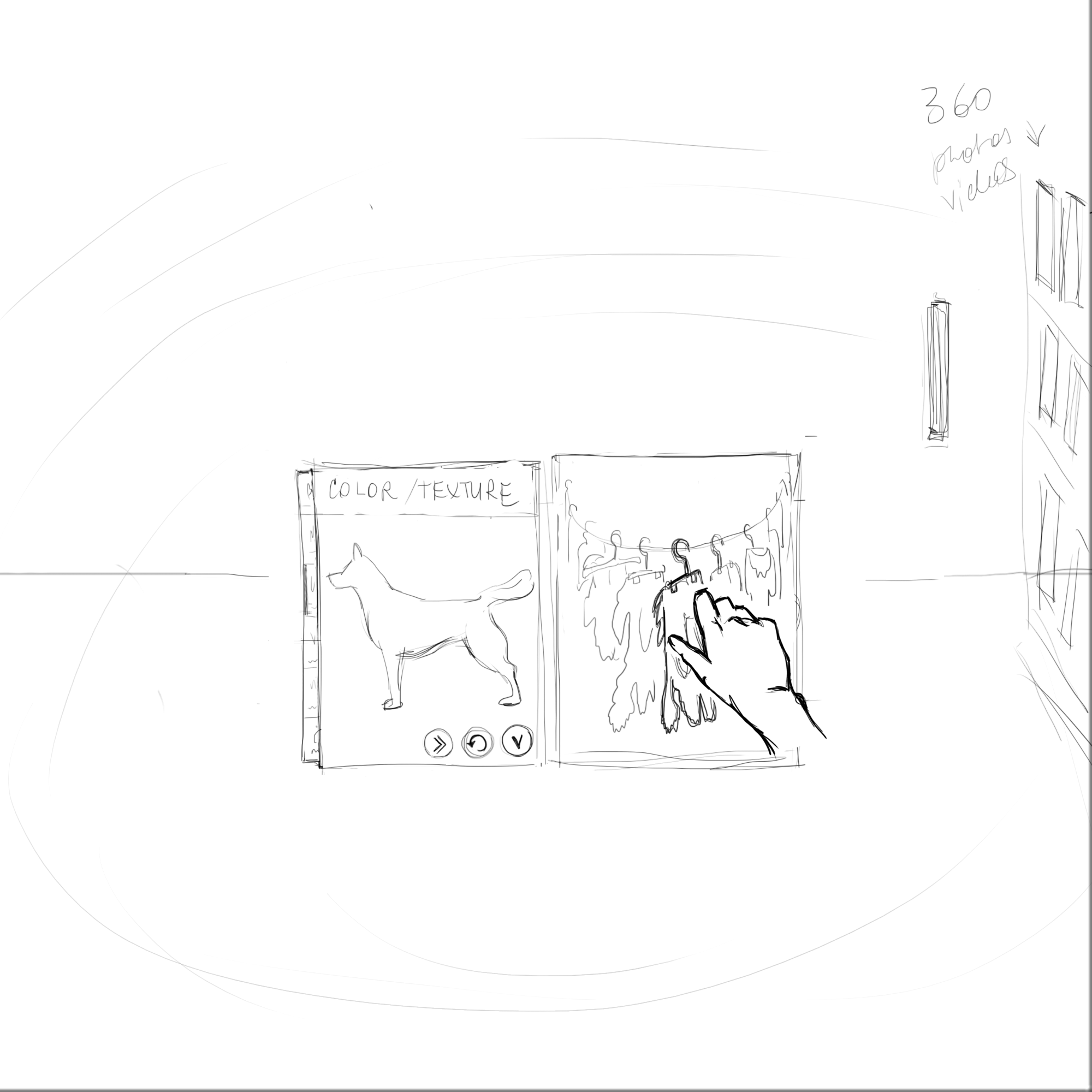
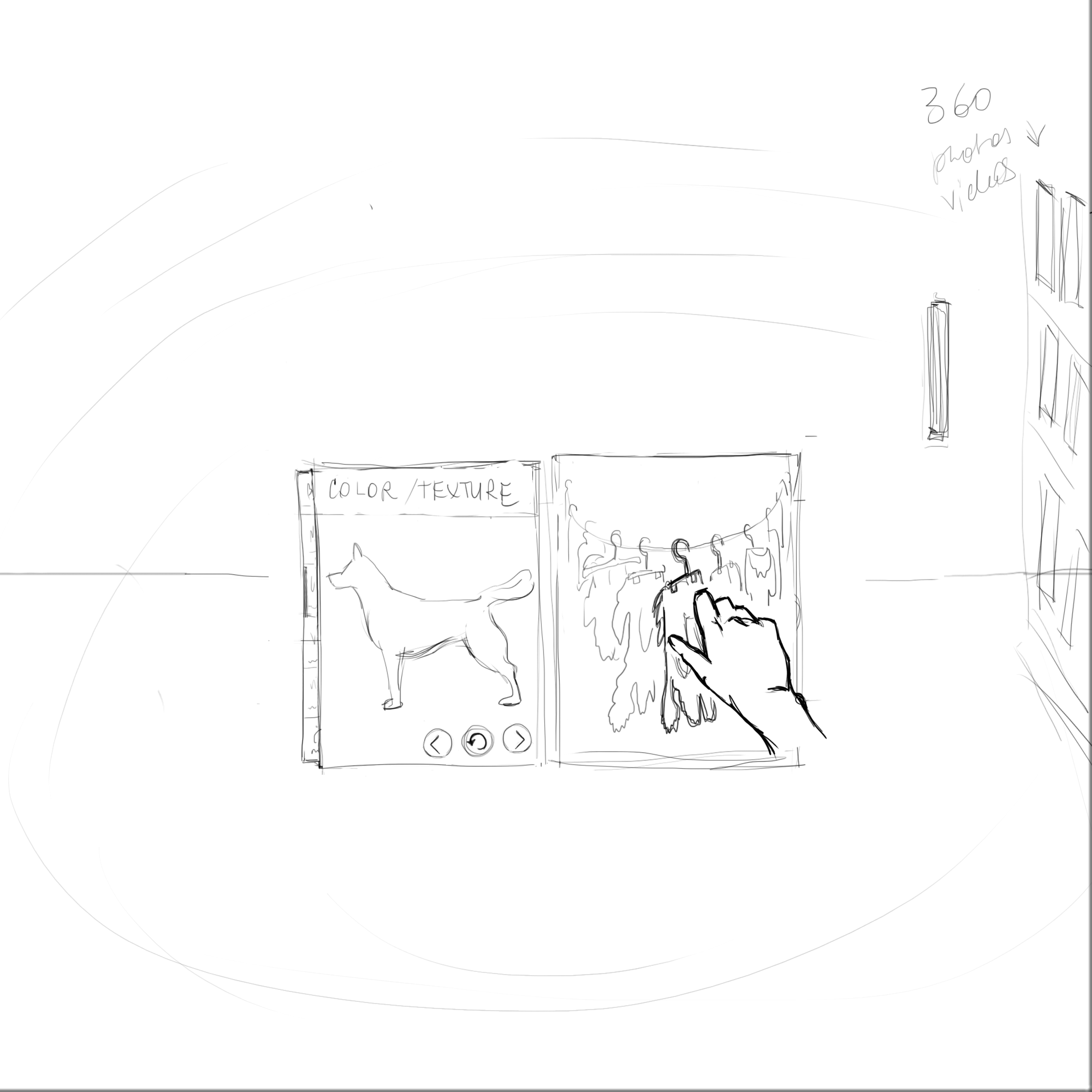
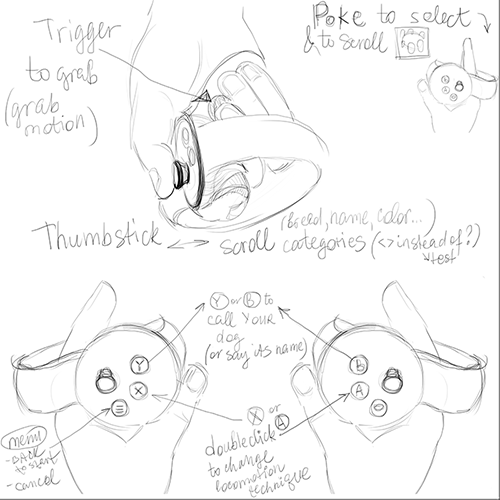
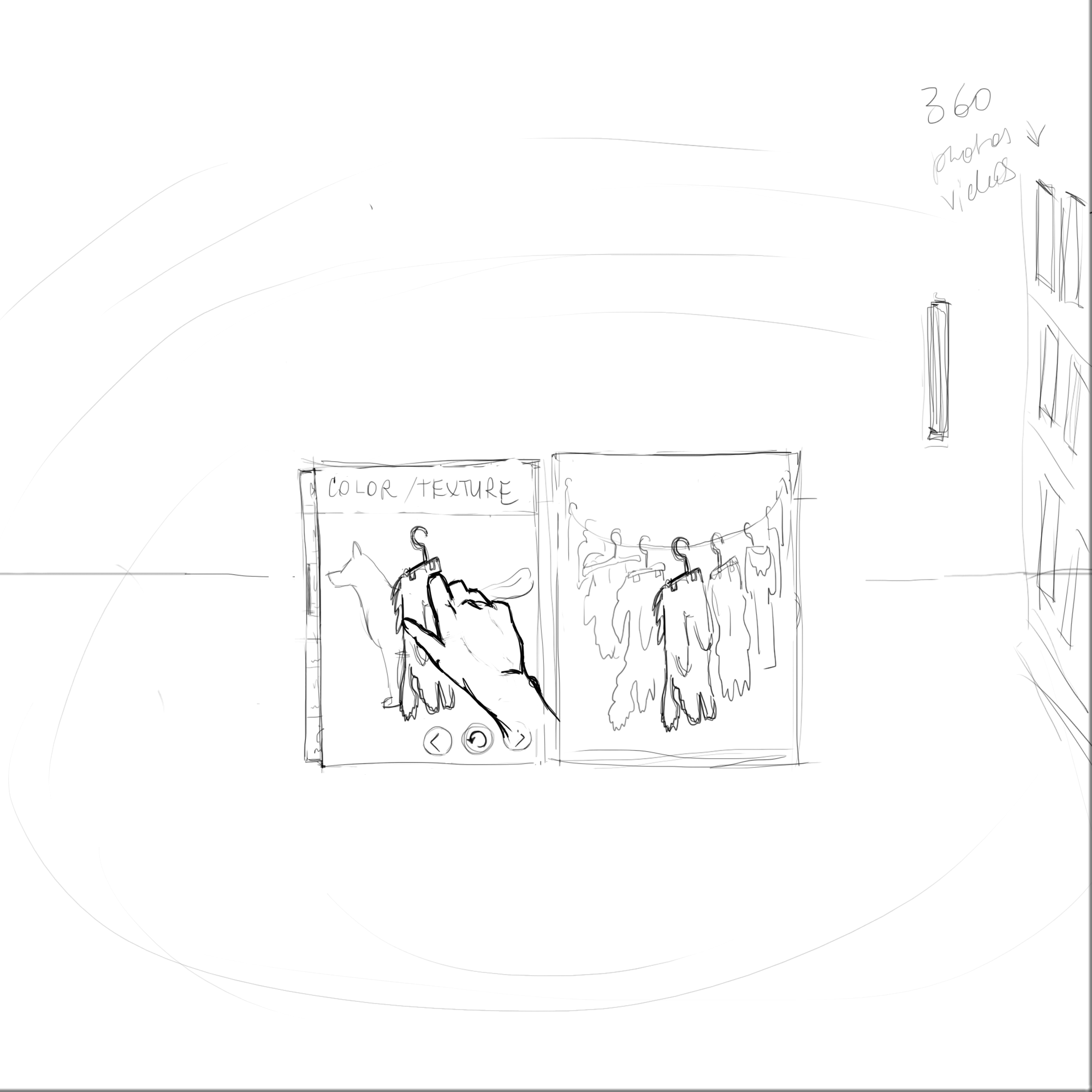
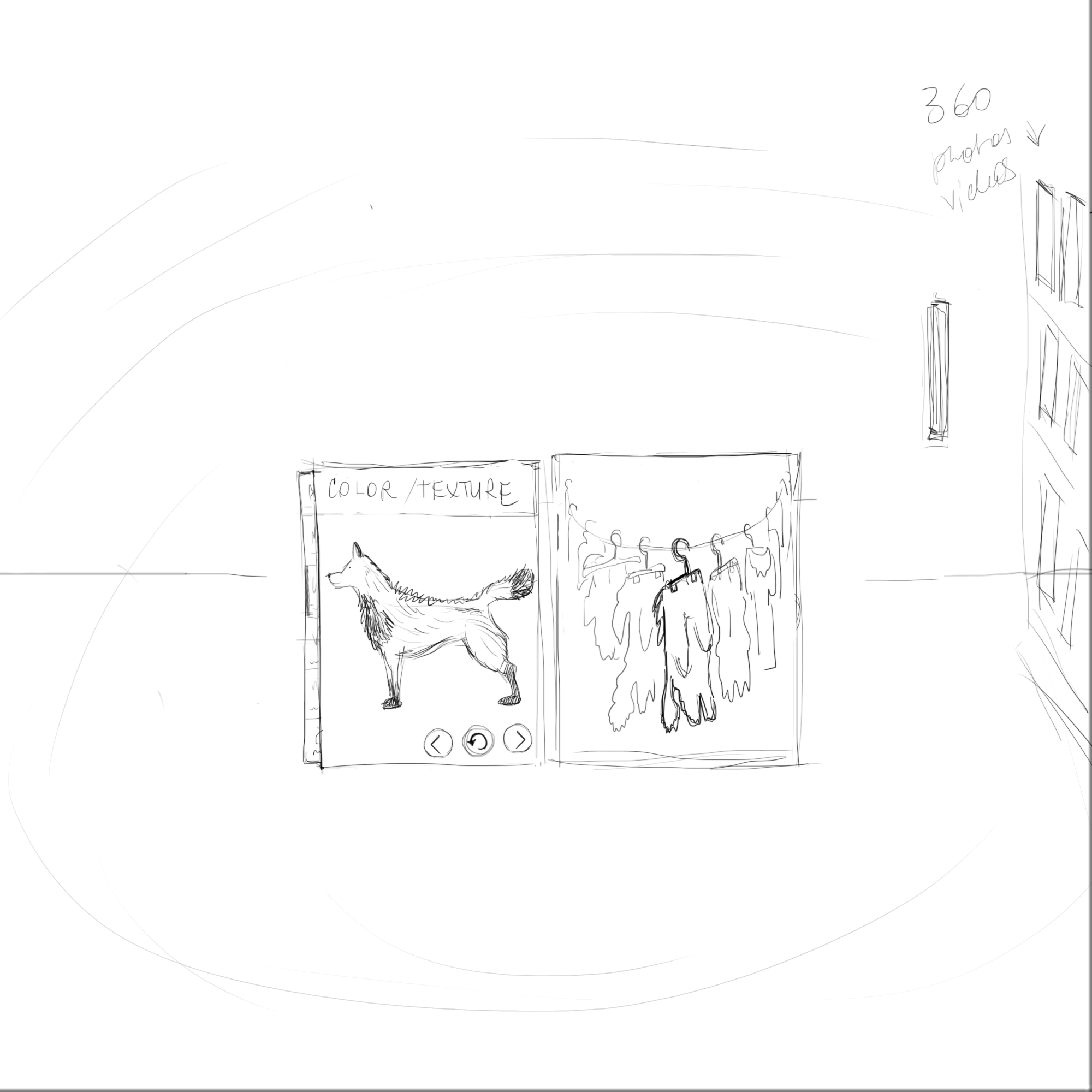

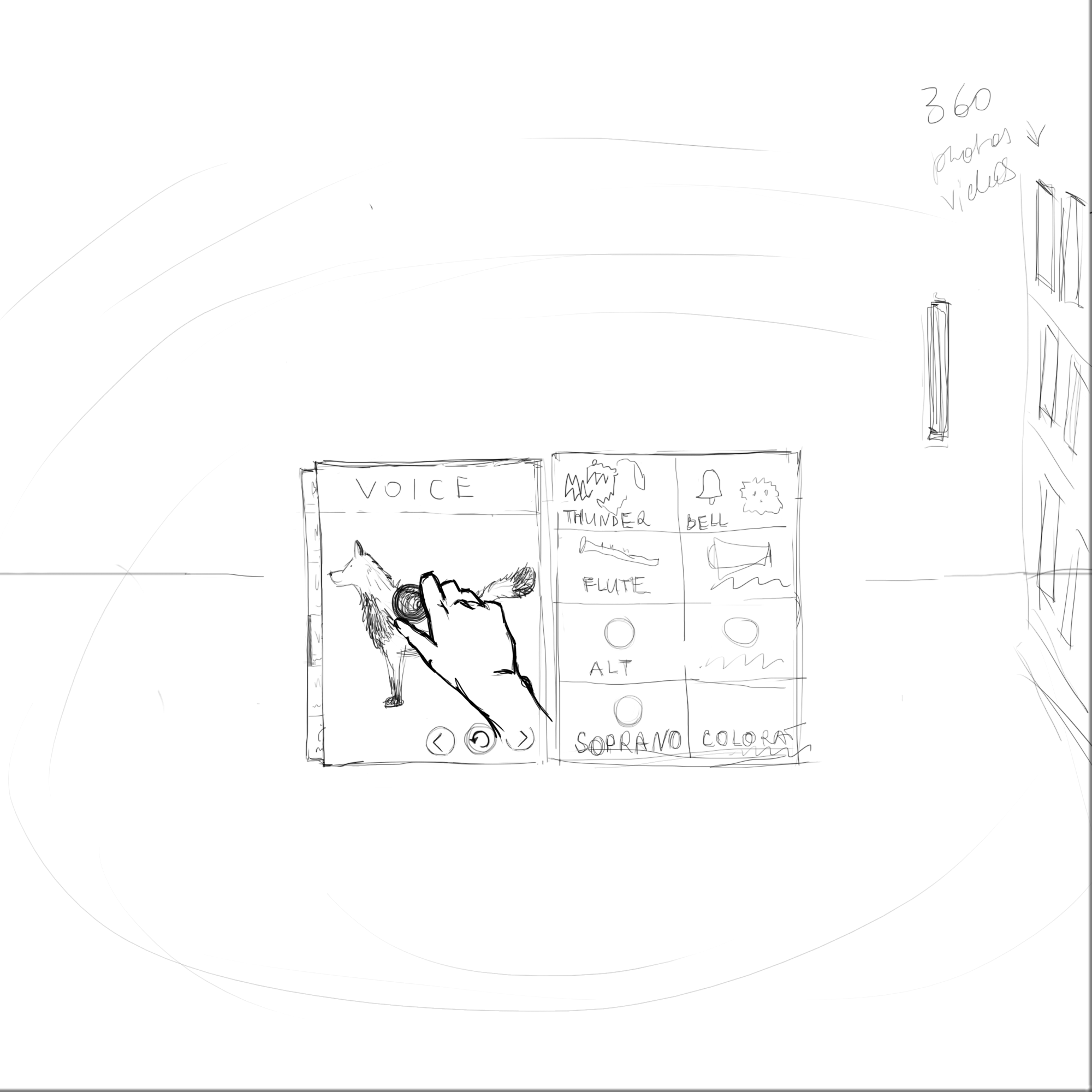
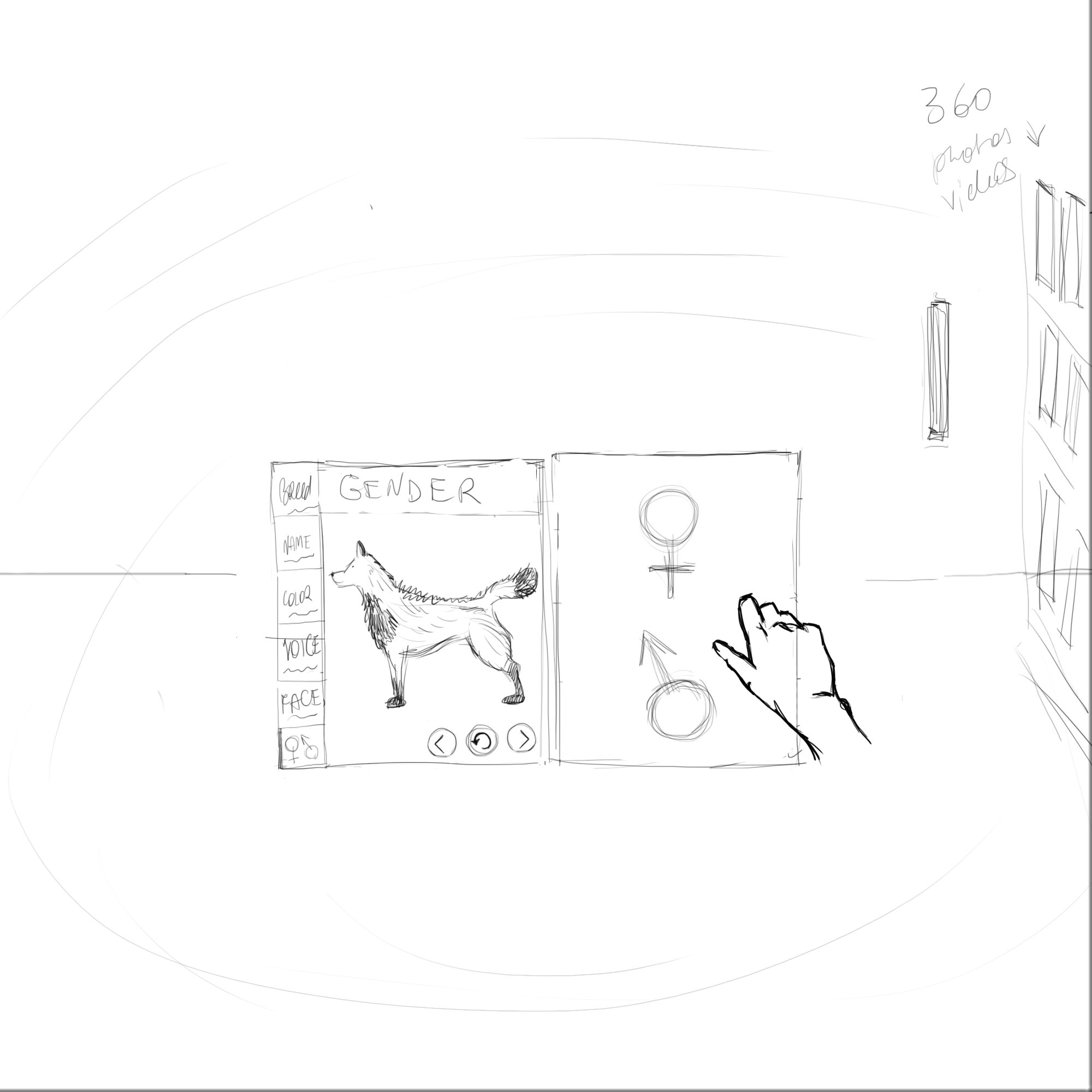
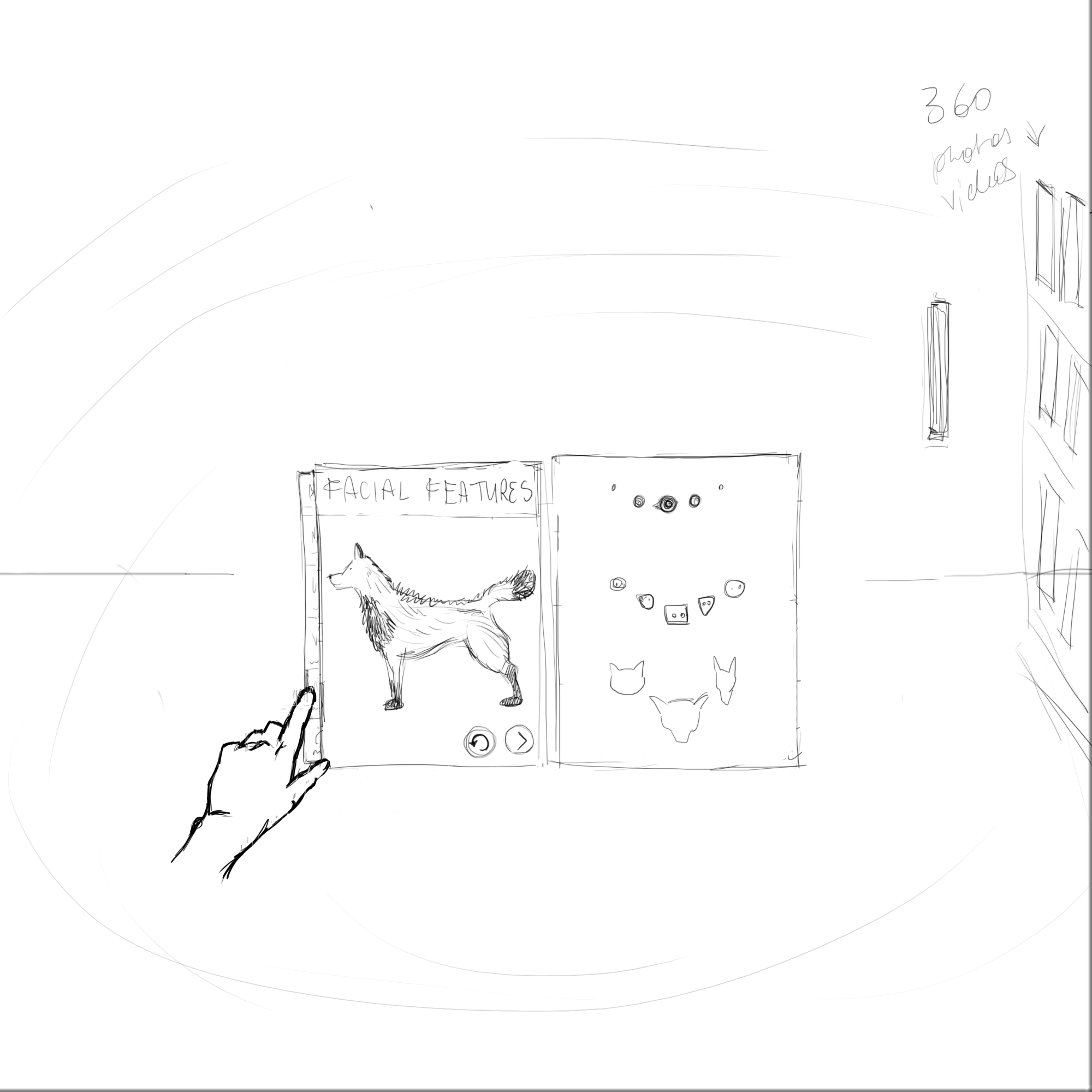


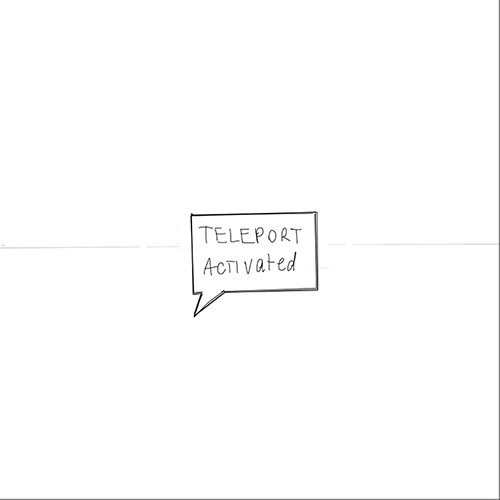
Menu drafts (made in Sketch):
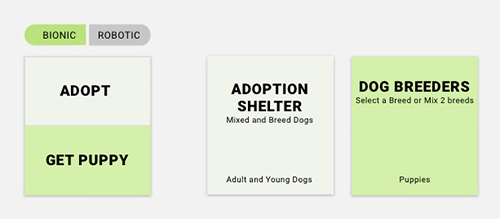
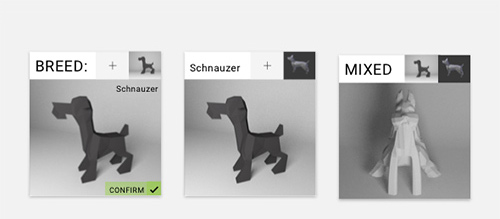
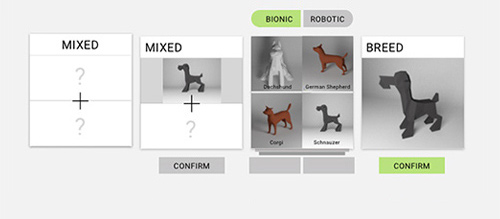
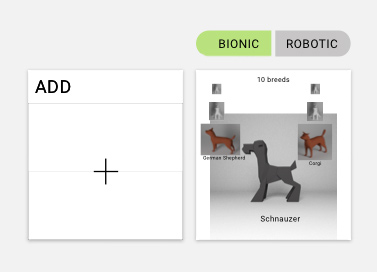
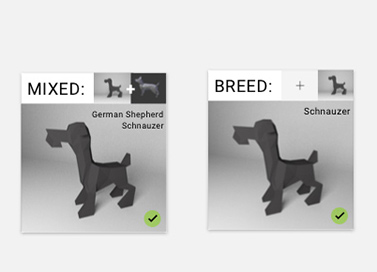
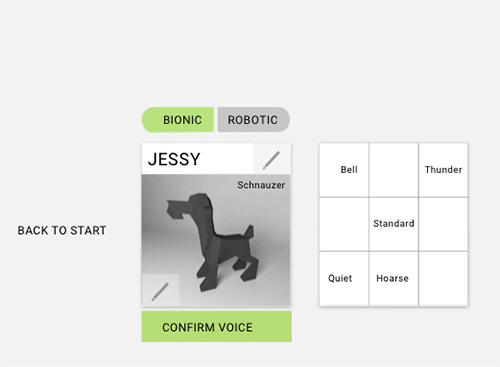

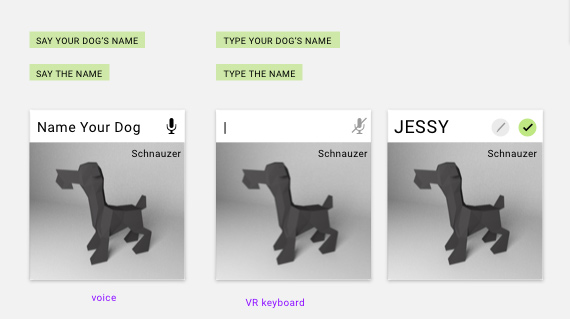
Greyboxing example (made in Unity3D):
I use greyboxing prototyping to test both, static and interactive scenes. Mainly checking proximity from the user and disances between the objects, how comfortable it is to reach certain menu buttons or manipulate objects, it's a great way to test the scales as well. Such tests also help to adjust the heights and angles. View from Oculus, using Touch controllers.
Icons (made in Sketch):
Selected icons are below. Inactive (white) and active (blue)
Menu (made in Blender). Some of the titles are in progress of testing to find out which ones are easier to understand for peopel (e.g., if to keep "Pattern" or change it to "Coat" which is also used to identify dog's type of fur including pattern). Icons might as well be adjusted.

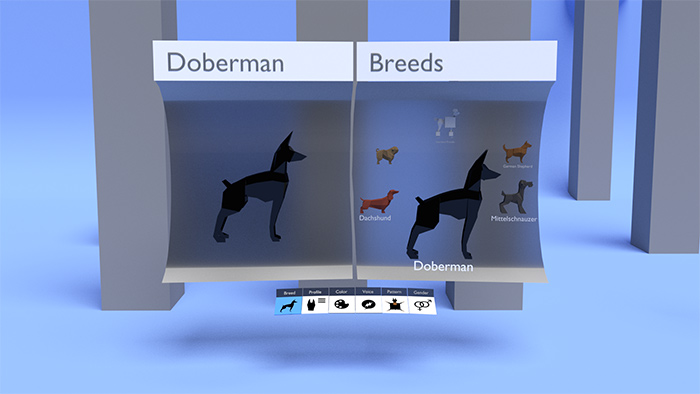
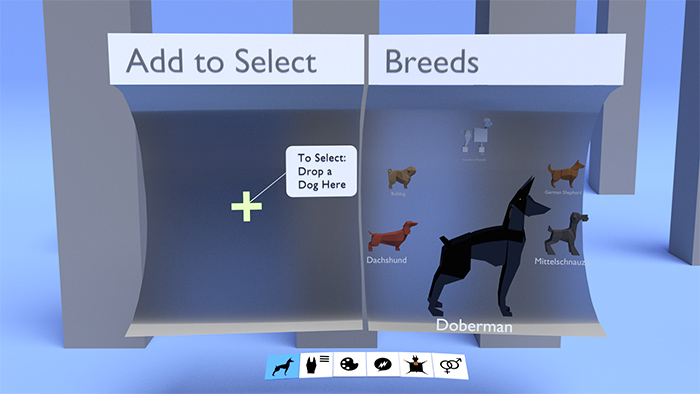

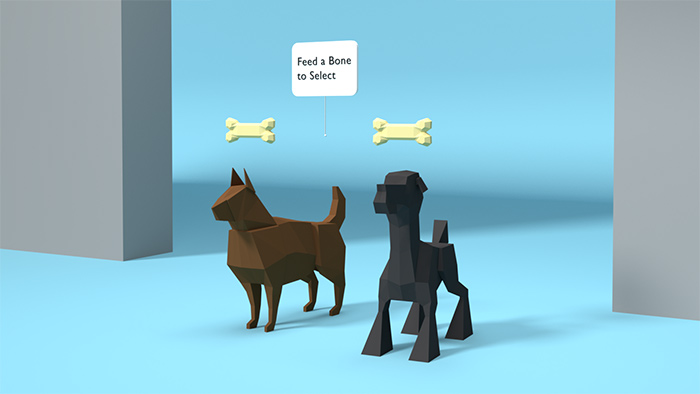

One of the alternative ways of scrollable items I considered. Each dog is located ona shelf that can be either scrolled using a controller, or a finger poking and moving a dog or a handle on one of the shelves.
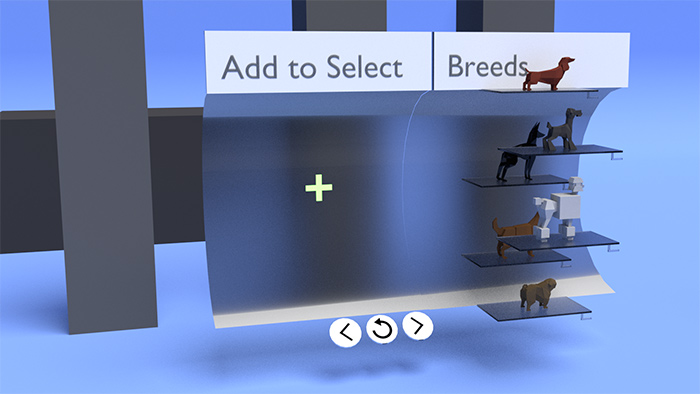
The next step is creating more detailed 3D prototypes and to test with people from TA. It includes some 3D Art, which I started working on during the 3D layout tests.
Before starting to work on the dog, I made an avatar research for animals and humans. I looked into games such as Spore, Project Spark, Minecraft (and Animal Daycare Roleplay), The Sims 3 Pets, Dog Sim Online – Robot Dogs, Animal Jam, but the most attention I put into VR games character exploration such as Valve's dog-like character you can play with, Farlands (Oculus), and other animal-related games I mentioned earlier, for animal/ creature characters types and customization.
For the way of human character introduction and customization I checked Sims, Star Trek Online, GTA 5 Online, Black Desert Online, Aion, Fallout 3 and 4, and some other. As well, " The Secret Life of Pets" showed very creative characters and behaviours. I gathered a lot of insights on the in-game creation process and the look and started working on the characters. My research included Facebook's avatar creation process and findings.
Working on 3D I apply the "Lean" approach of testing and iteration to ensure the models have the right look for TA, evoke the right feelings and work well in terms of function (rigged and animated well). For the final files the following should be met:
Convex mesh with 255 polygons max. (assuming these object will collide)
Keep it in quads
Ensure the meshes are planar
"Lean" construction, rigging and animation processes (start simple, test soon, iterate quickly and repeat)
Below are the draft examples of some of the types of the dogs in their different design stages, from sketches to retopologized and rigged 3D models (made in Blender, in progress).
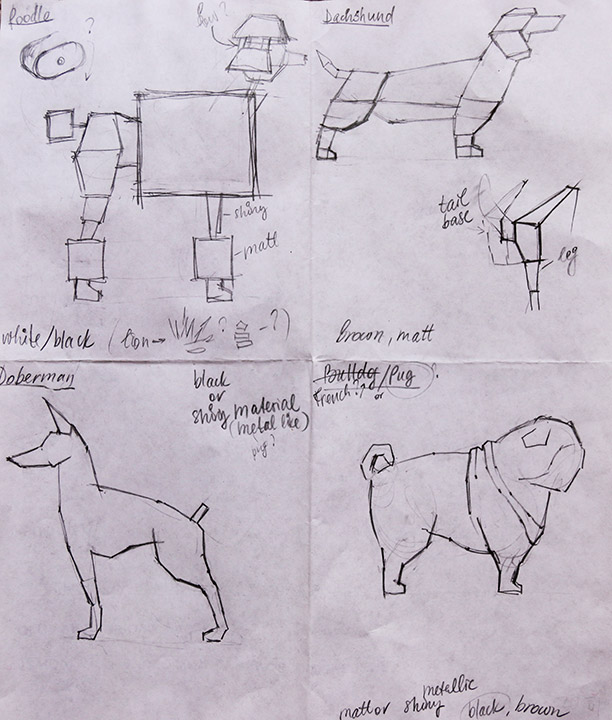

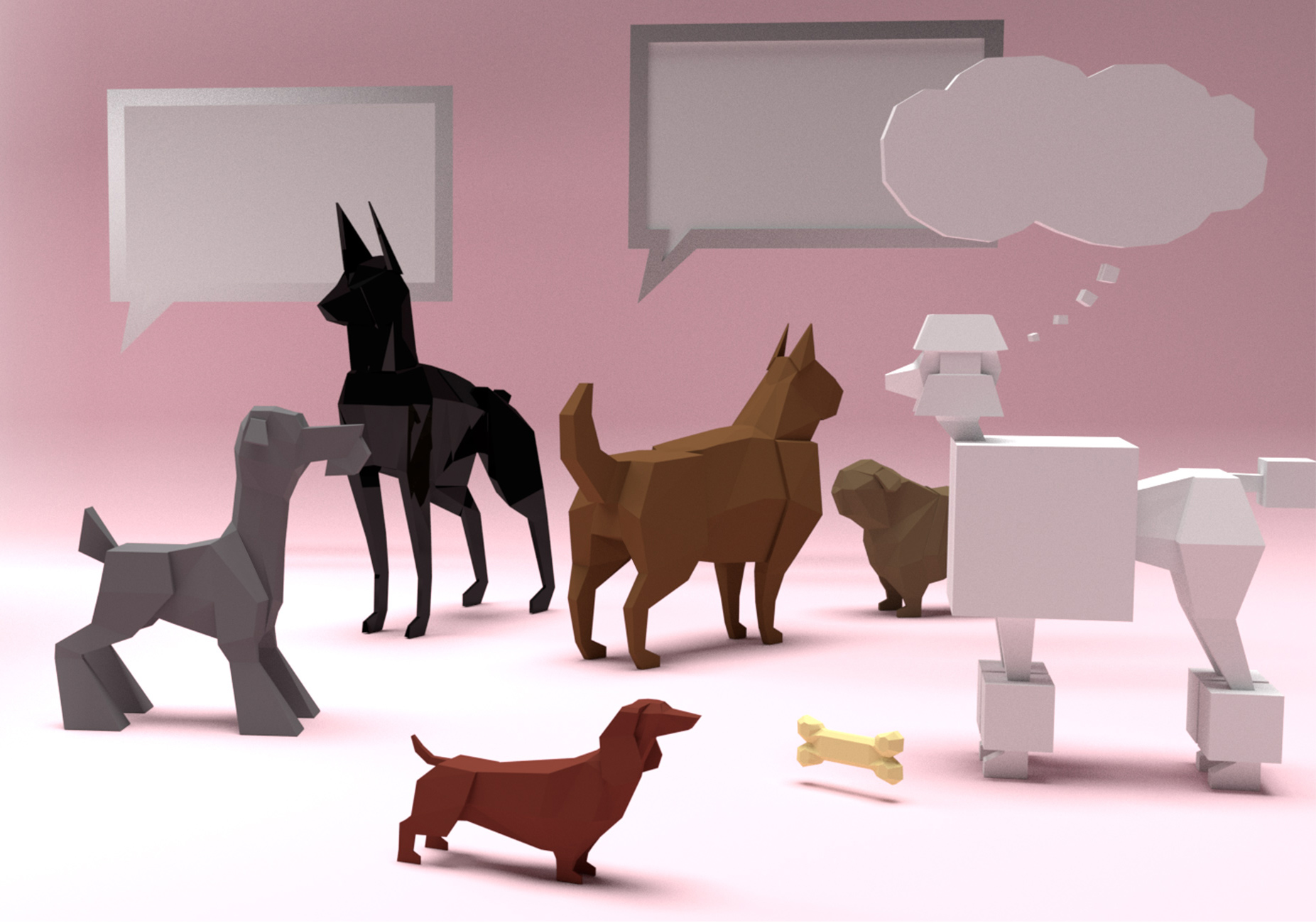
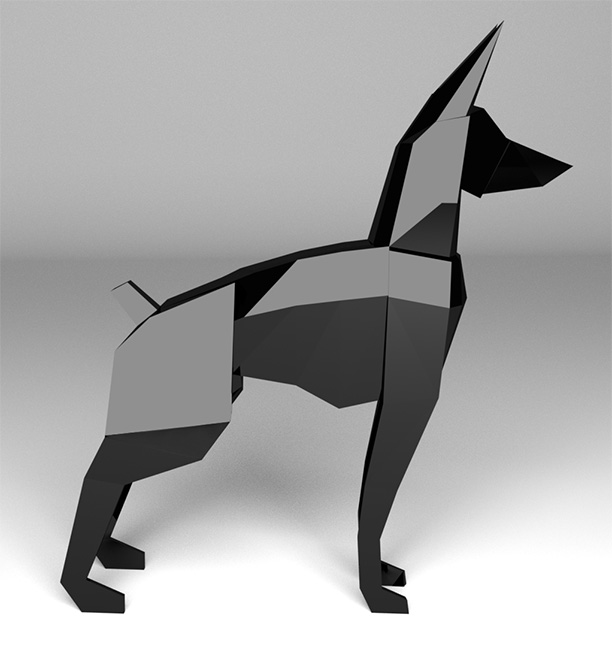
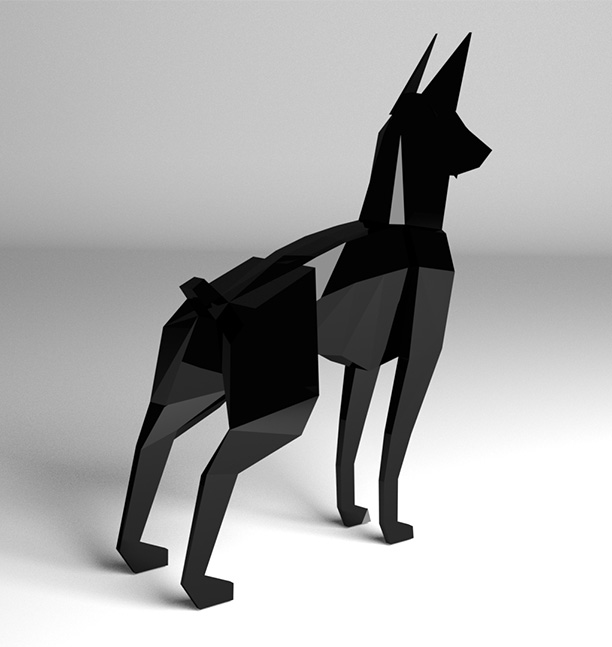
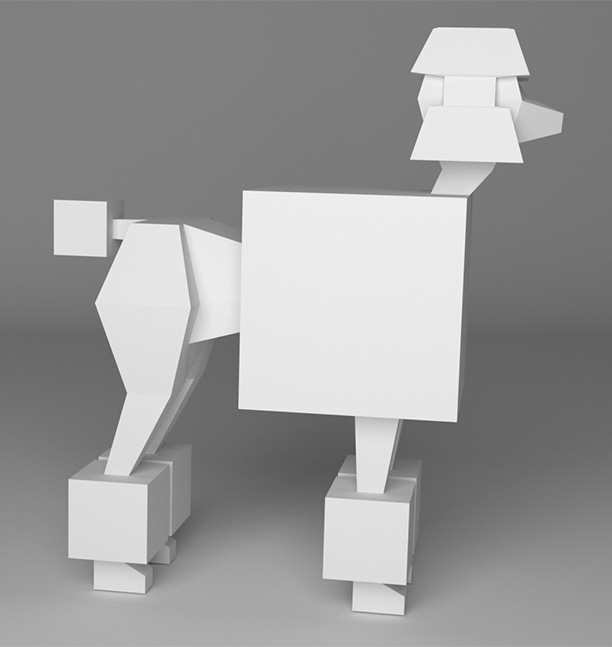
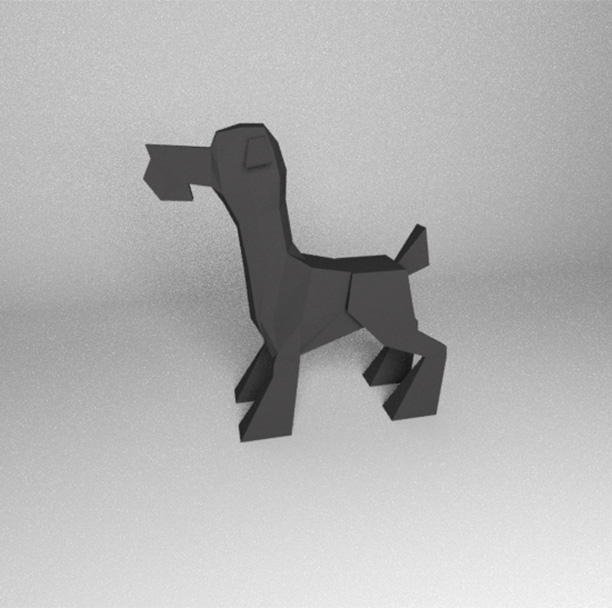
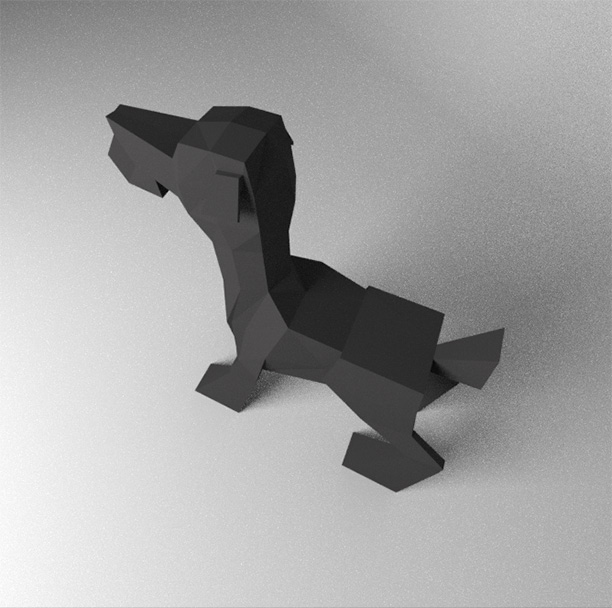

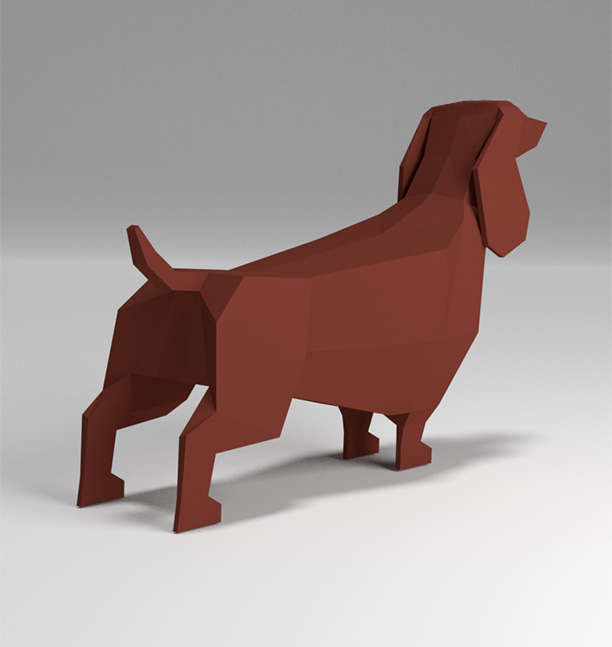
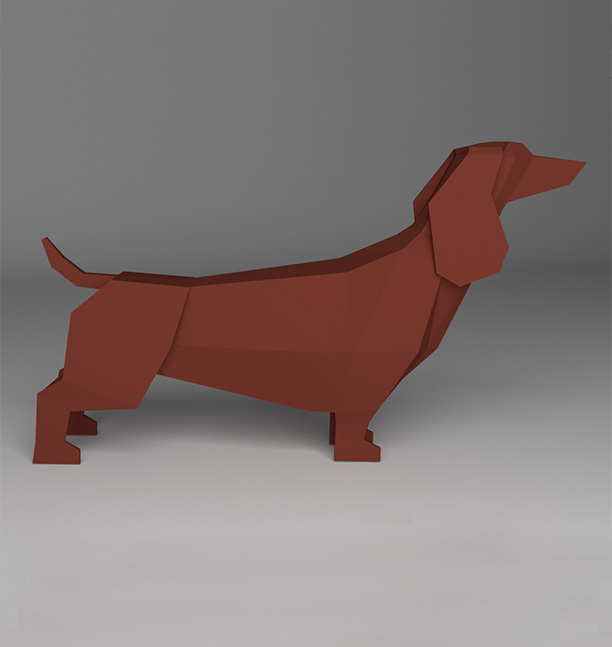

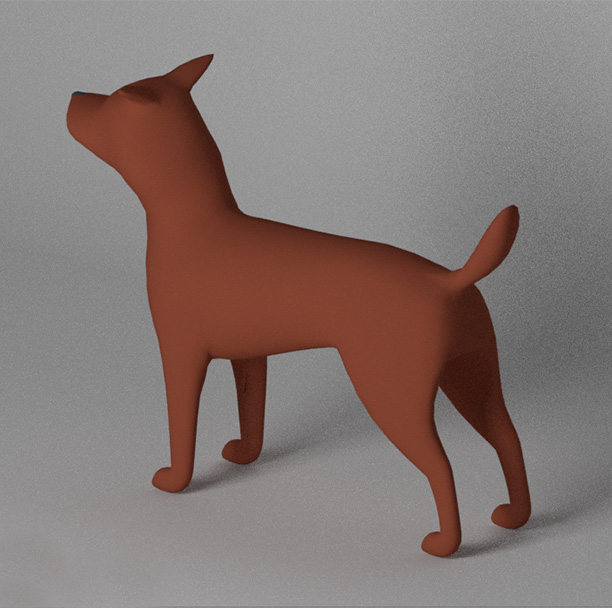
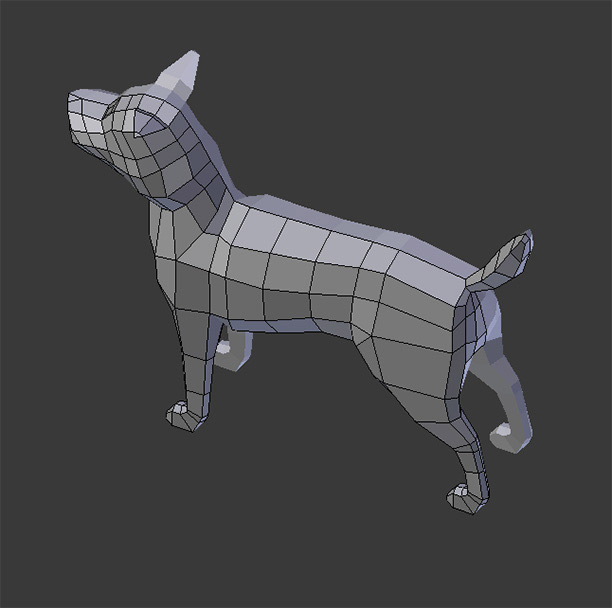
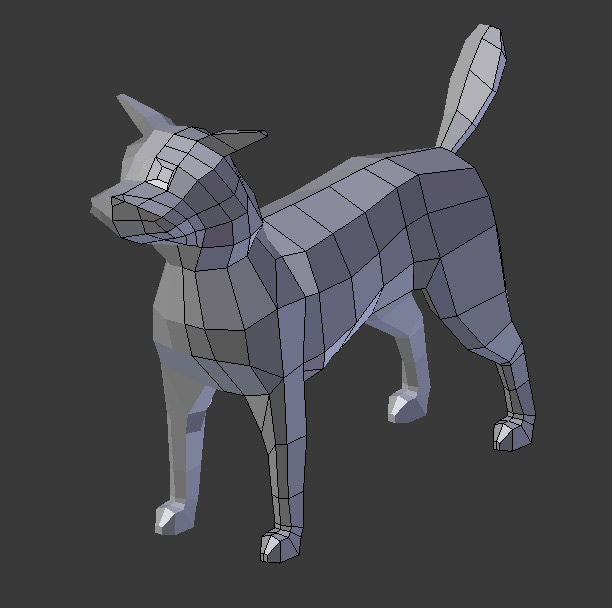
During the rigging process, I made some modifications to the model. I followed an actual dog skeleton, its main leg bones' number, in my rig. To create an armature and movements I used Inverse Kinematics Bone Constraints. After skinning the rig to the model I started animating the dog, creating rough draft animations – blocking animations – to choose the key poses. I created a walk cycle, chose timing and poses, and checked the mesh to see it in motion and decide on the next iterations. I also tested some poses and specific movements. Some examples are below.
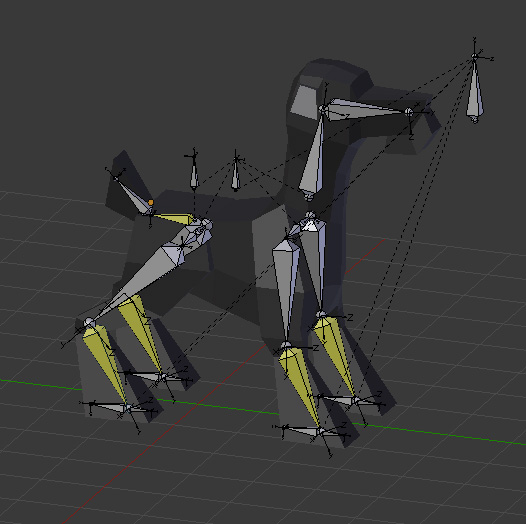
Below is the work plan, currently using Asana to manage the tasks. The board below is for "Pets" project.
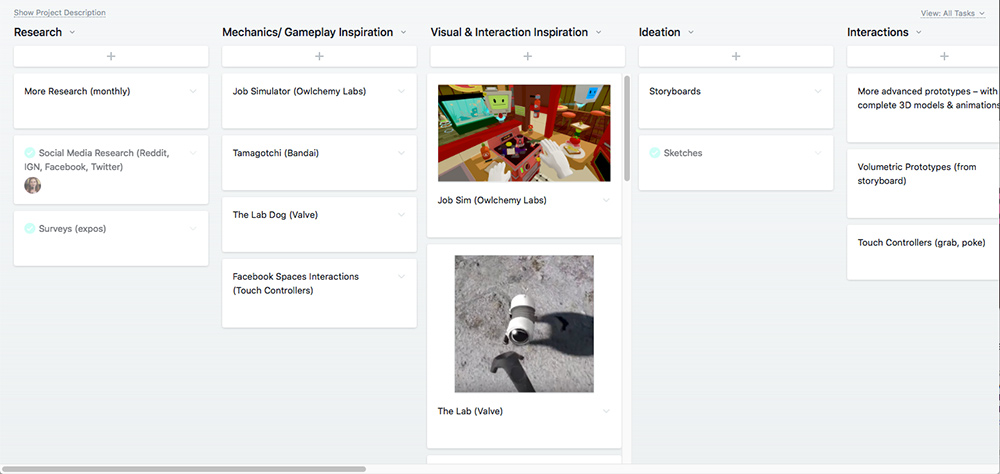
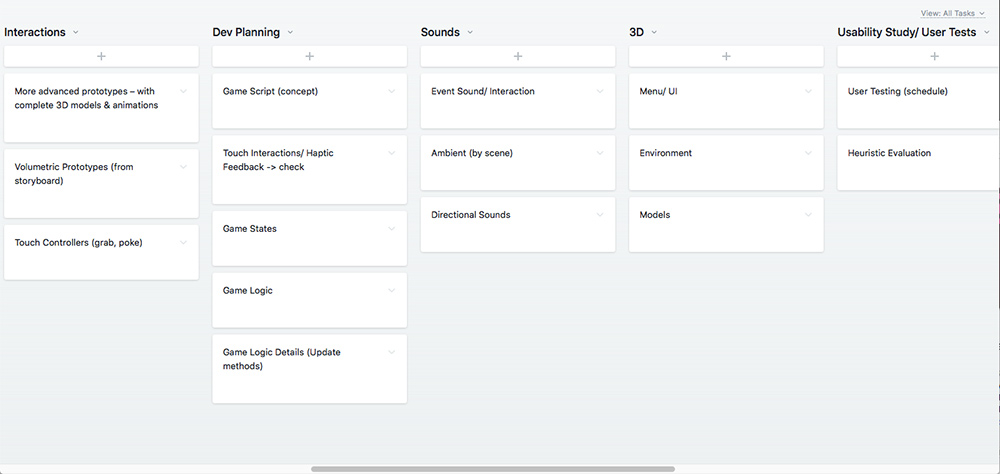
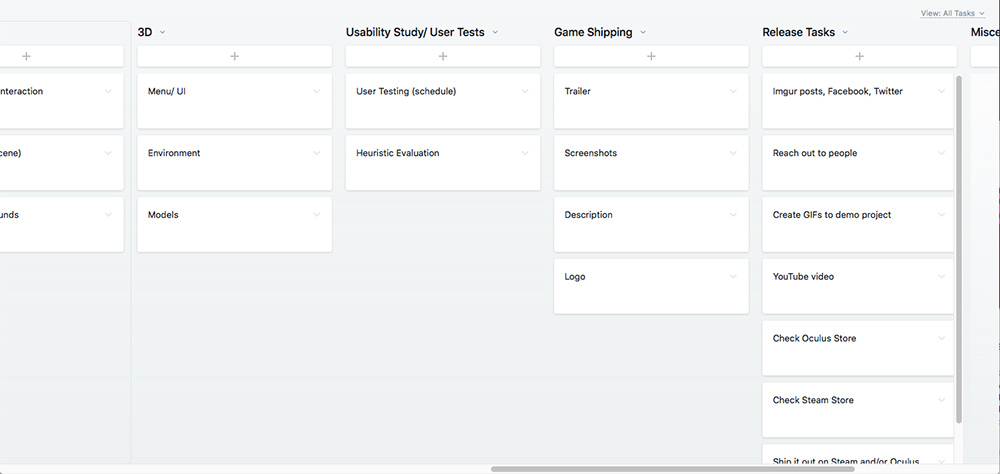

To be more confident in the design solutions, make the right business and user focused decisions, and secure longevity of vision, I started working more precise on the mental models following the Methodology by Indie Young: "Mental Models. Aligning Design Strategy with Human Behavior".
Mental models are a large part of what holds many people back from VR at the moment, as uncovered through my previous research and can be found here: What people do when placed in VR and here: How people use certain VR apps, their feelings and thoughts (New vs. Experiensed users).
I am concentrated on knowing more of the type of experience described above (social, pets), knowing what people expect from such VR experience, how they feel about it, to understand better what behaviours and interactions to create, how to make the existing designs and structure better, what other possible types of VR experience are desired.
Another big point on my work is empathy. Not only concerning the pet situation, but in a big part concerning VR experiences and HMDs, their usability and comfort. Creating with an empathy with a New Inexperienced VR User. I talked to people, observed and looked if patterns appear, also watched the vocabulary people use and worked on uncovering their perspective concerning VR.
When working on VR UX, UI, characters etc., I regularly test the small parts of the prototypes, to observe and learn about people using this VR build.
In progress. This case study may be updated along the way of design and development but most likely will be finished after the experience is deployed and public. Please contact me if you'd like to know more or/and to see few more examples. Currently, I am working with Cardboard VR viewer and Oculus Rift.
Product Design; Brand Strategy; Design Sprint; Product Management; IxD/ UX; Visual Design/ UI/Illustration/ 3D; VR storyboarding, VR prototyping, VR Design; Animation; Motion graphics; Usability Studies/ User Testing.
© 2019 Olga V. Ivanova